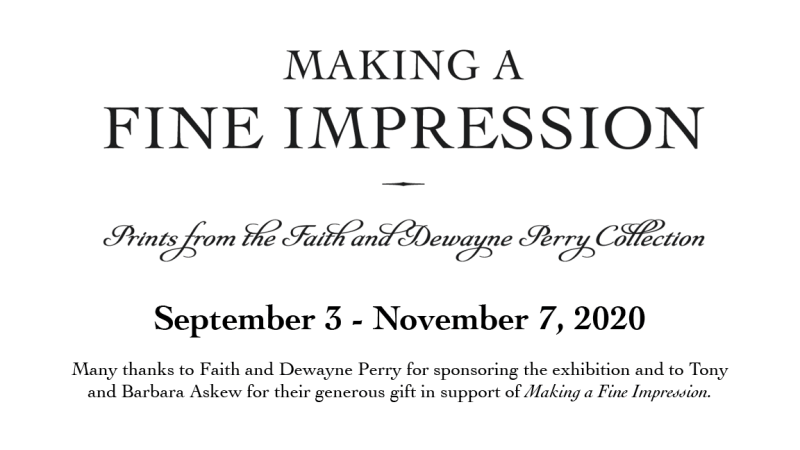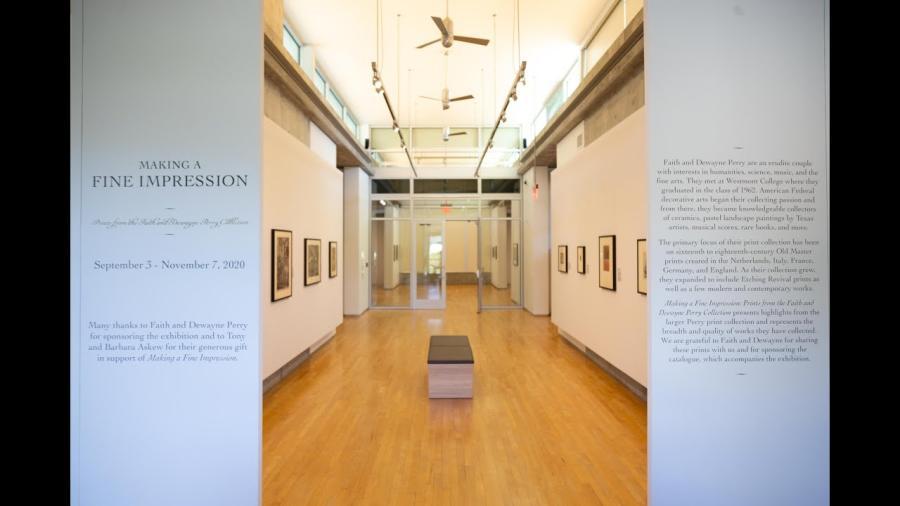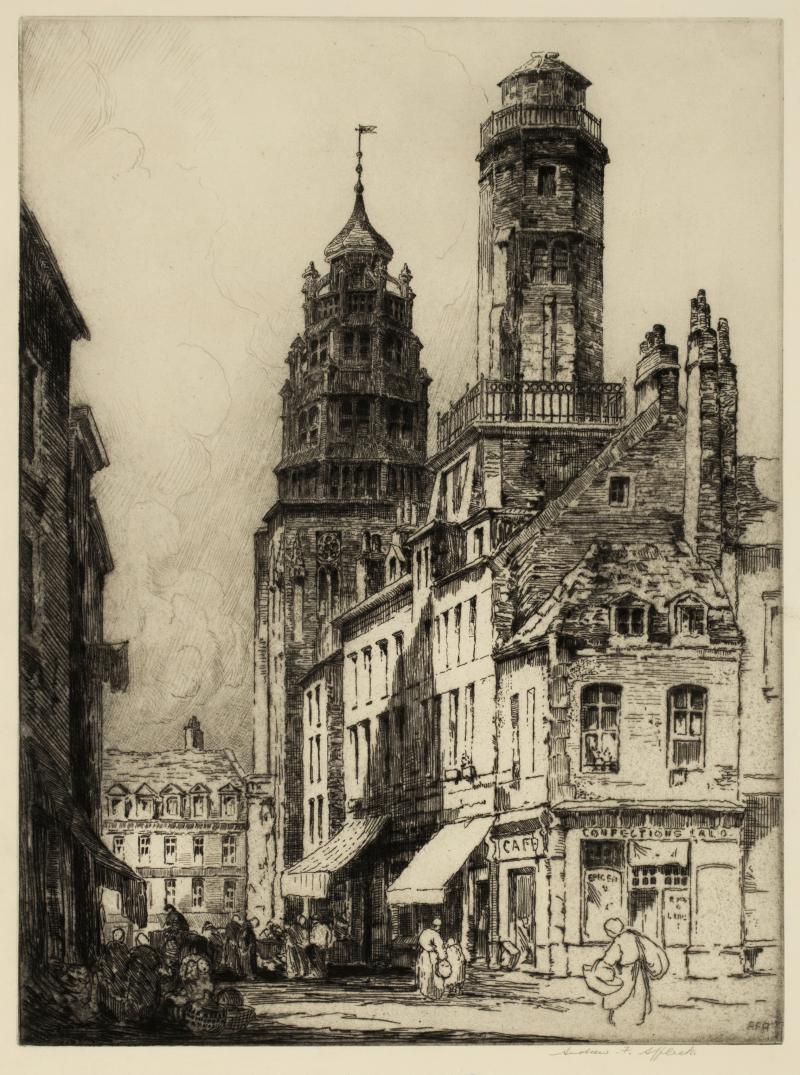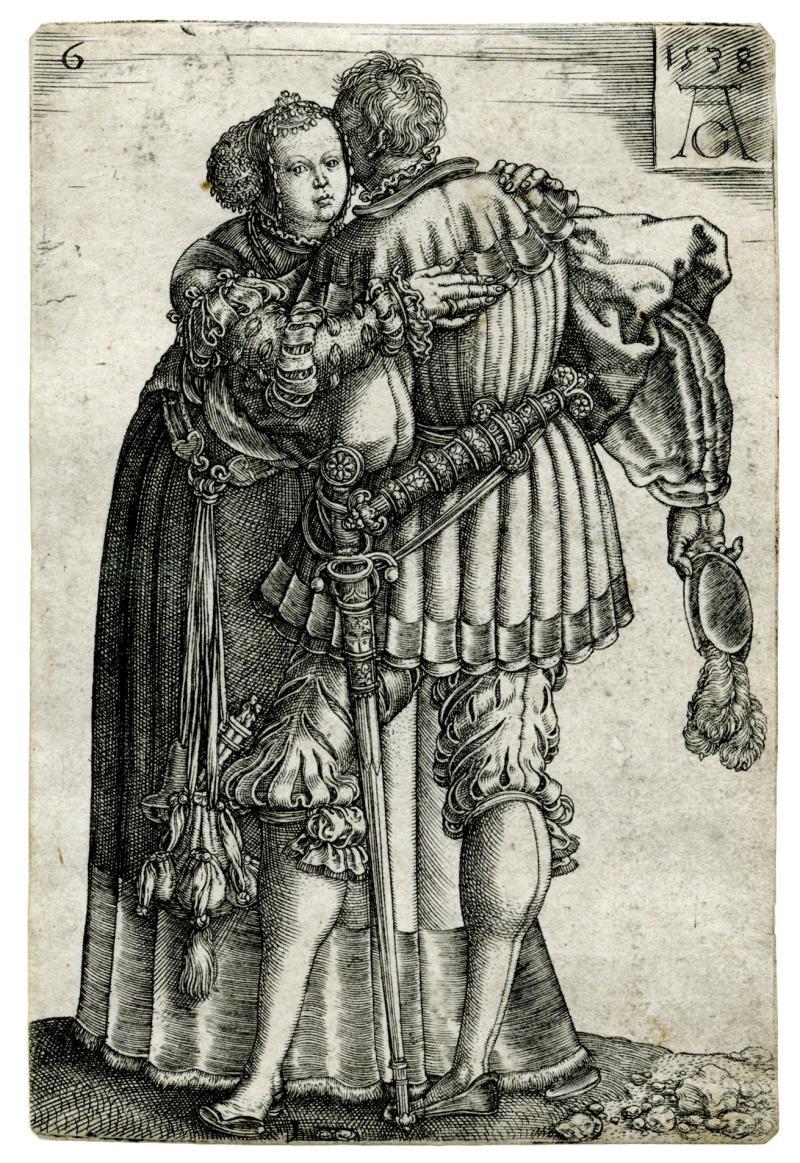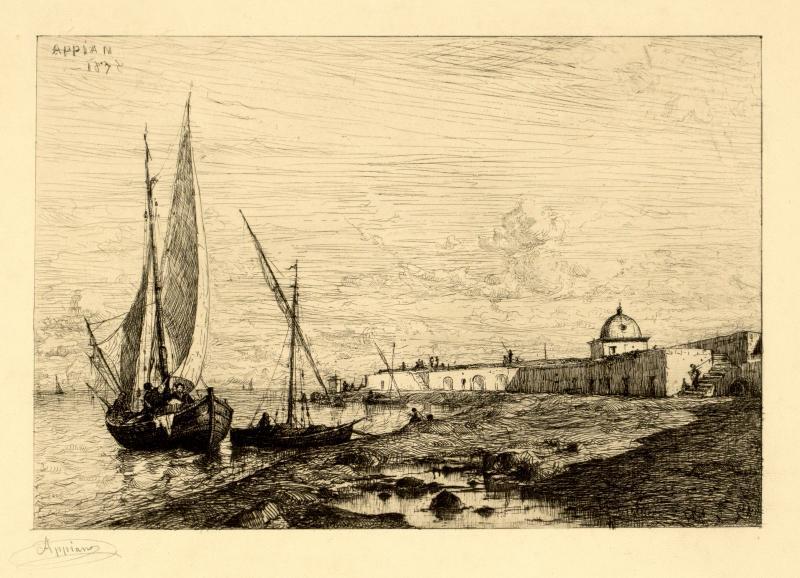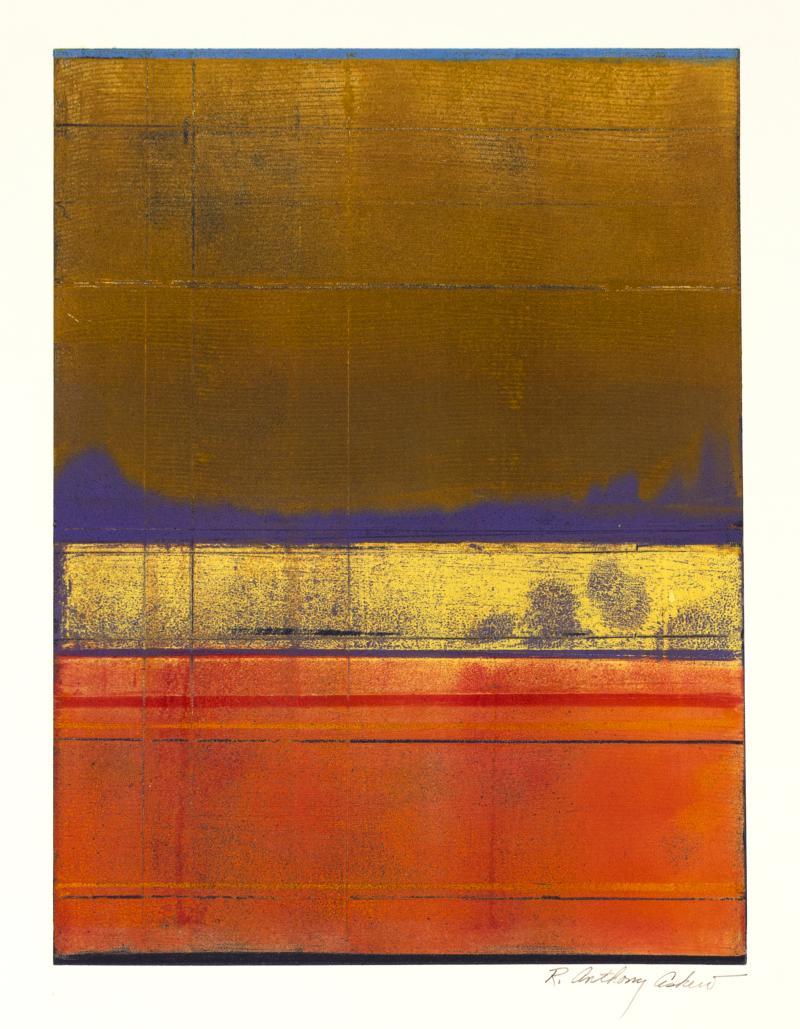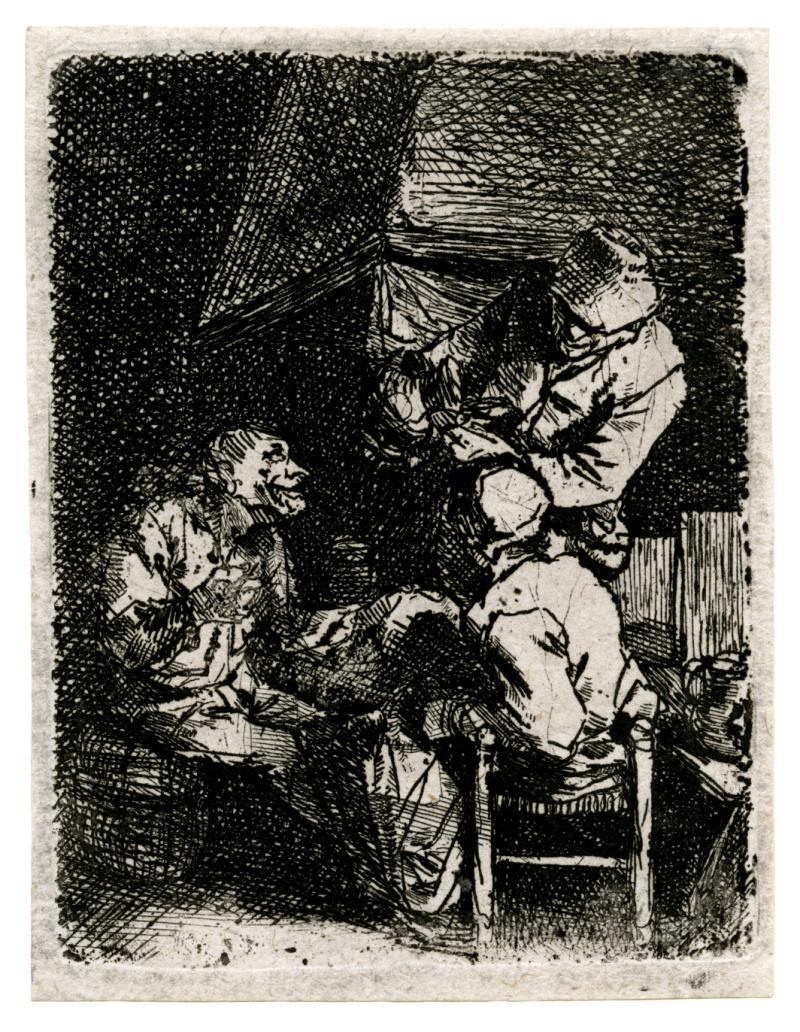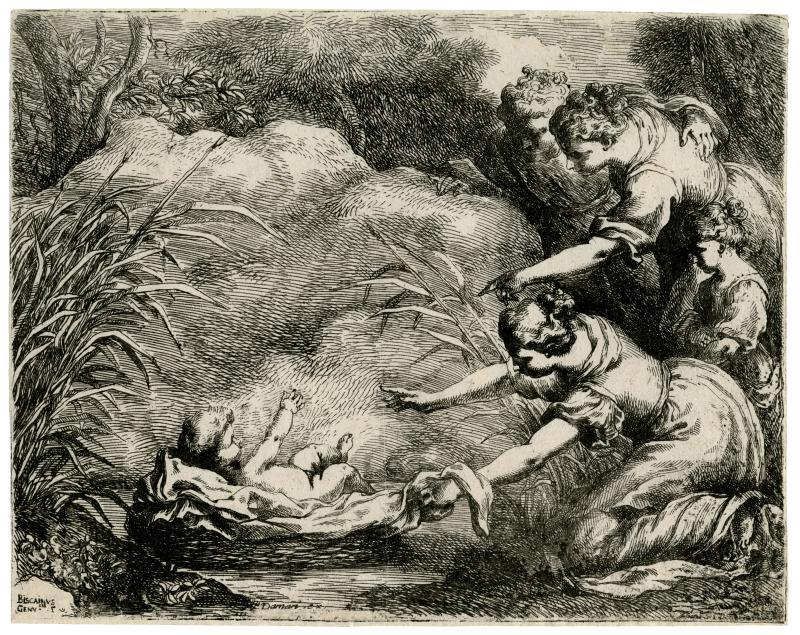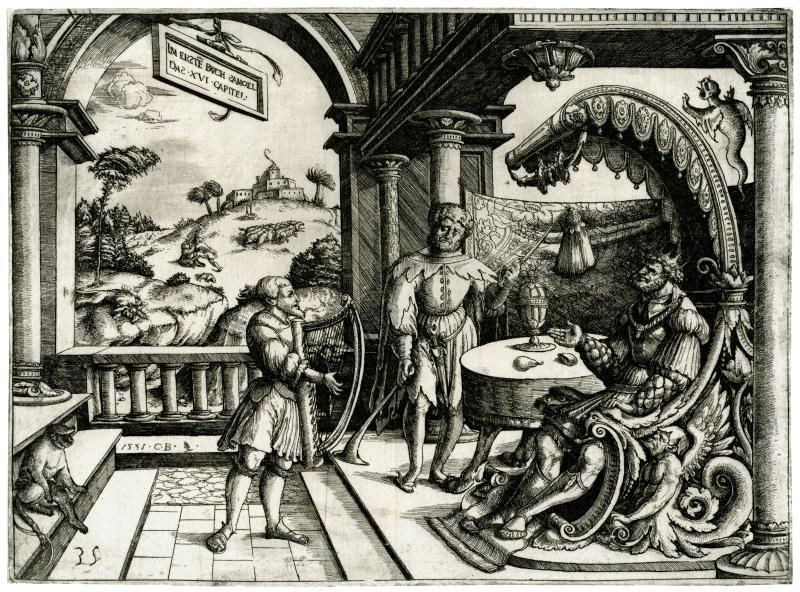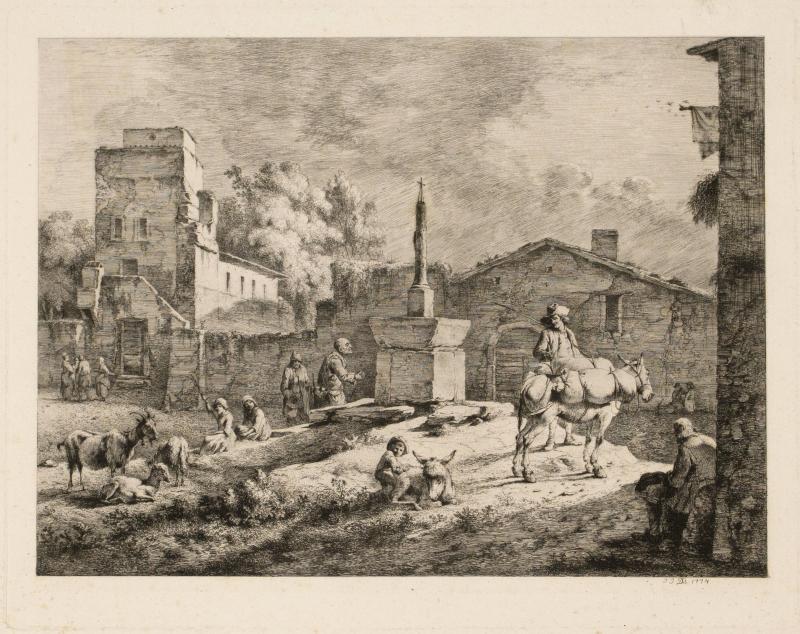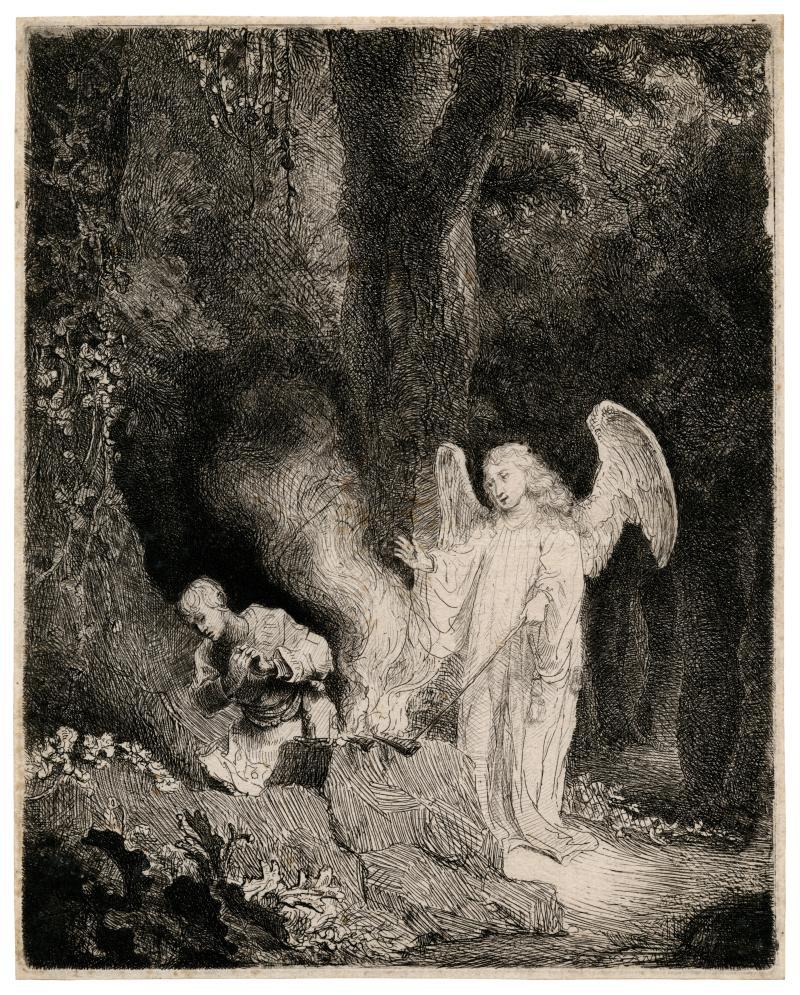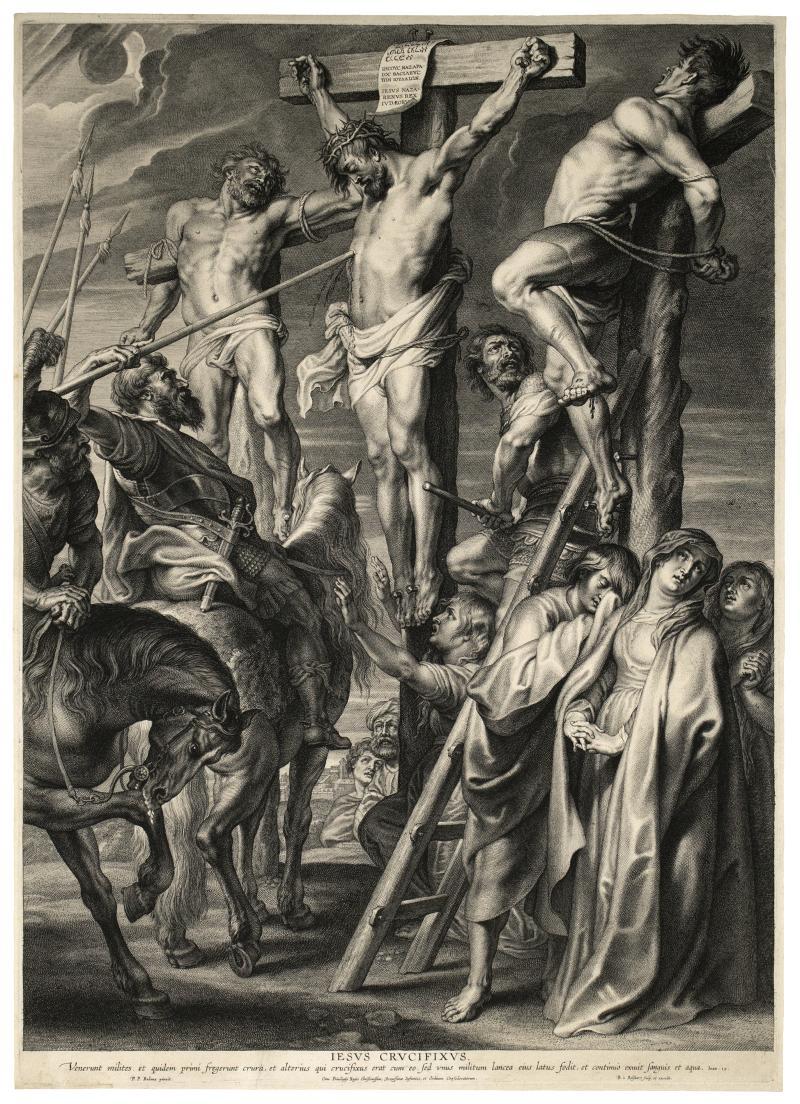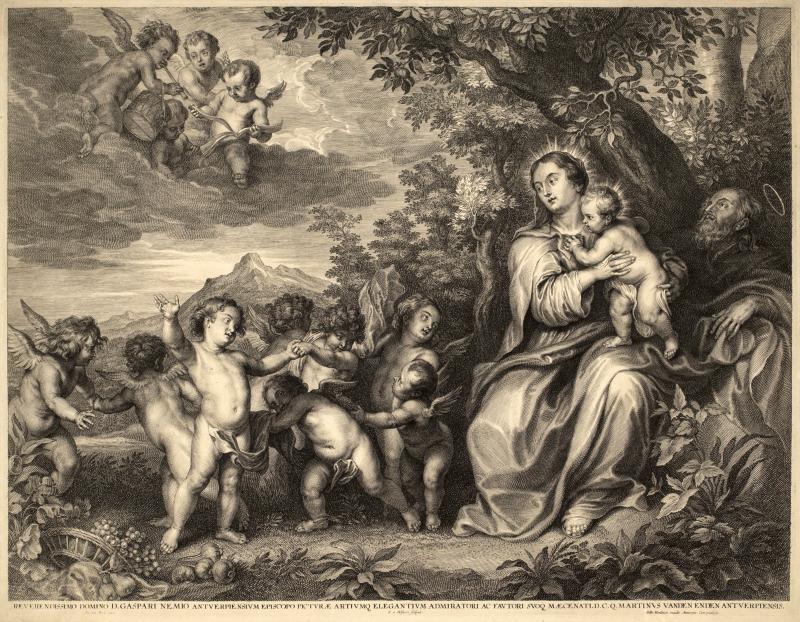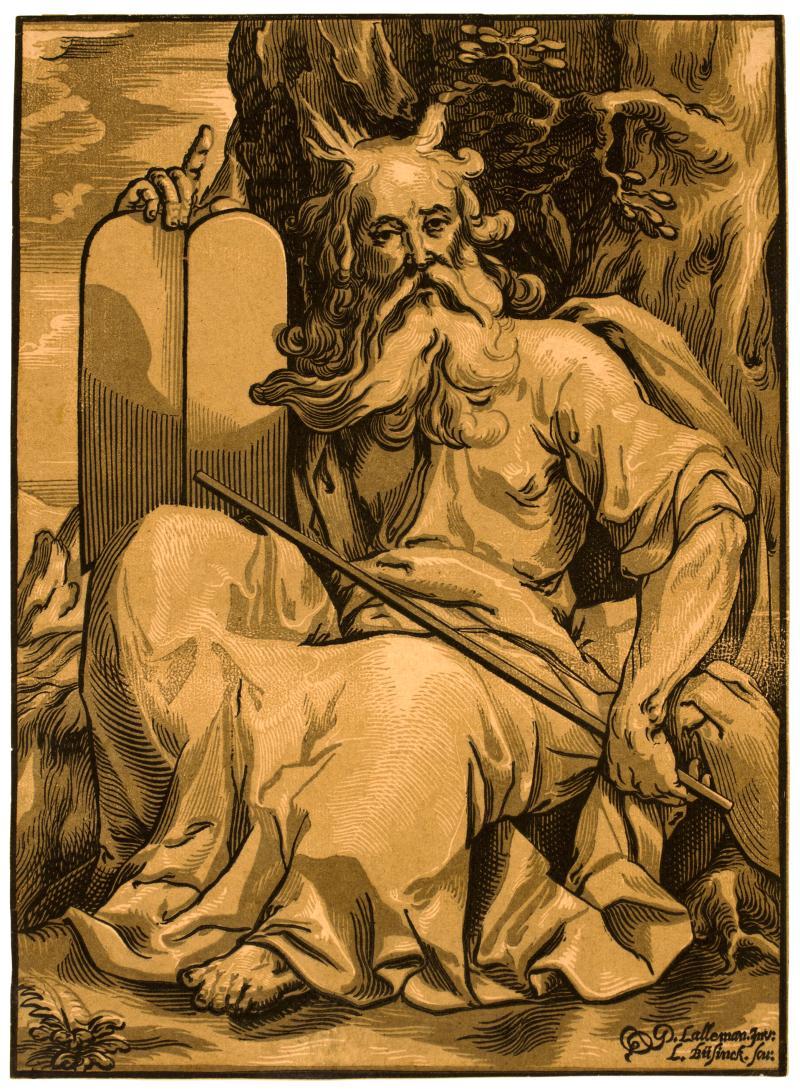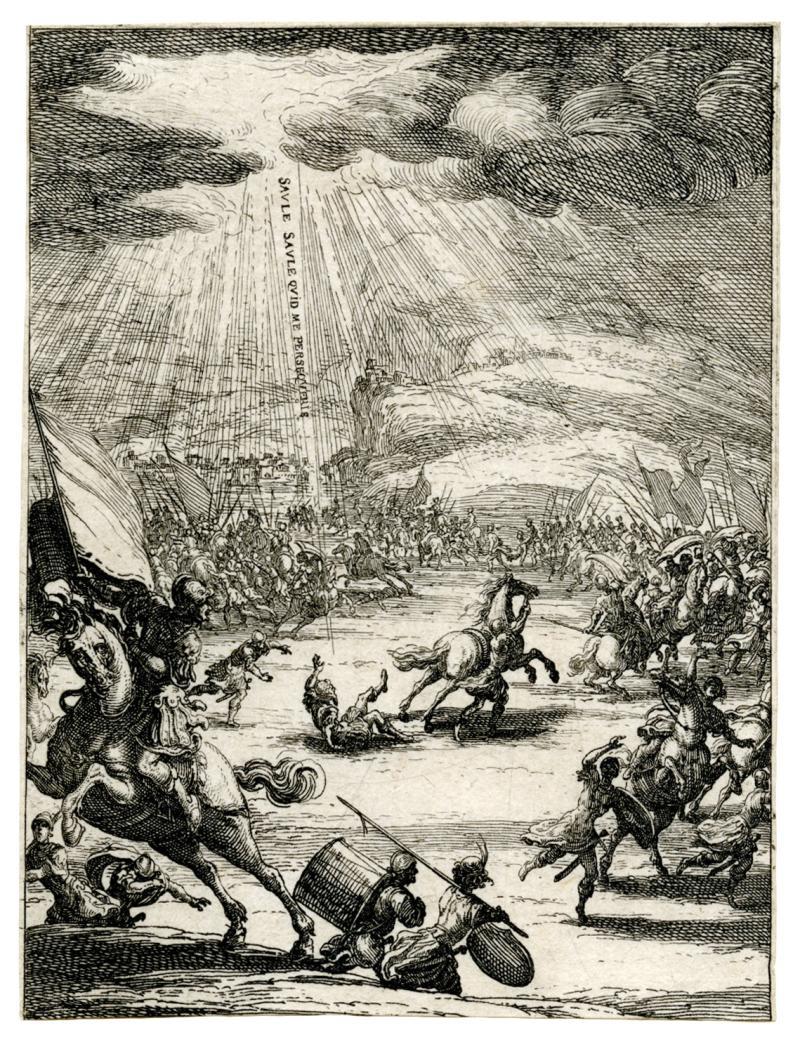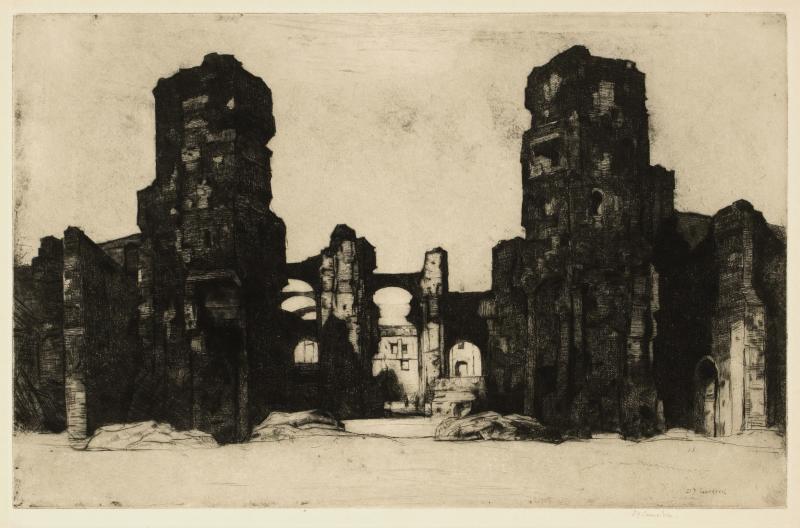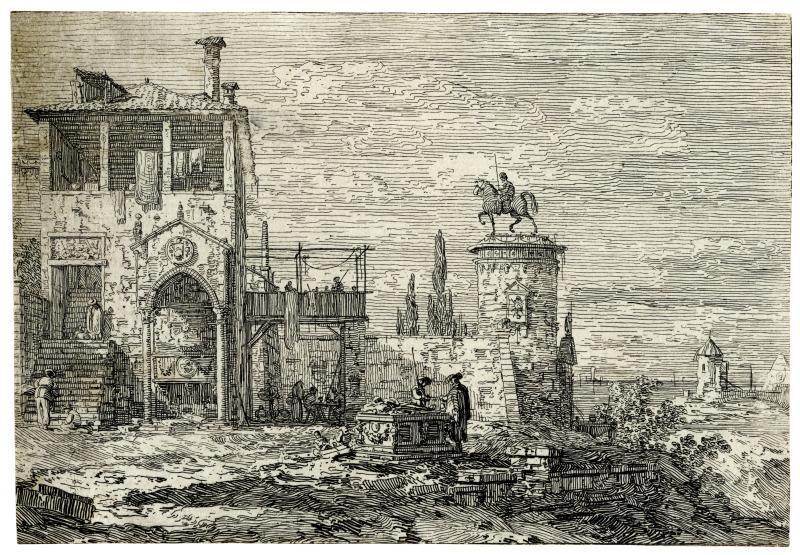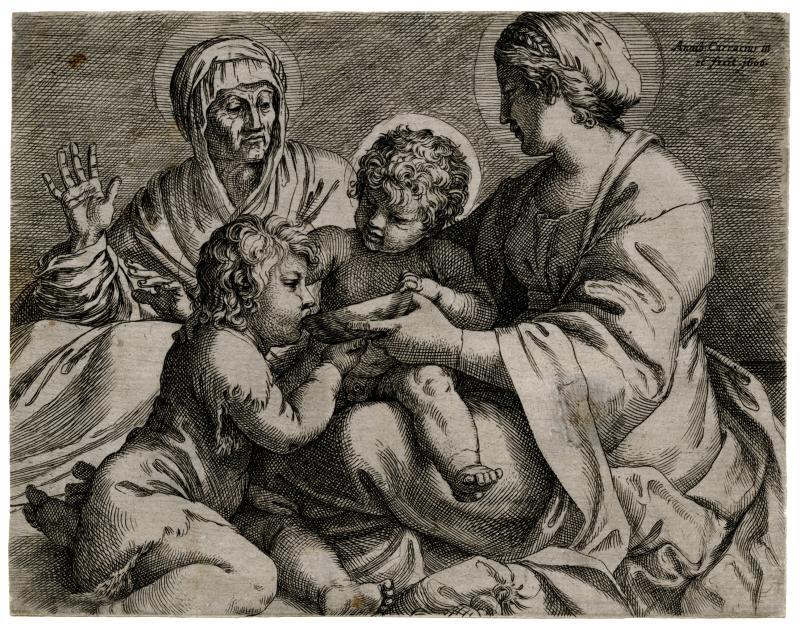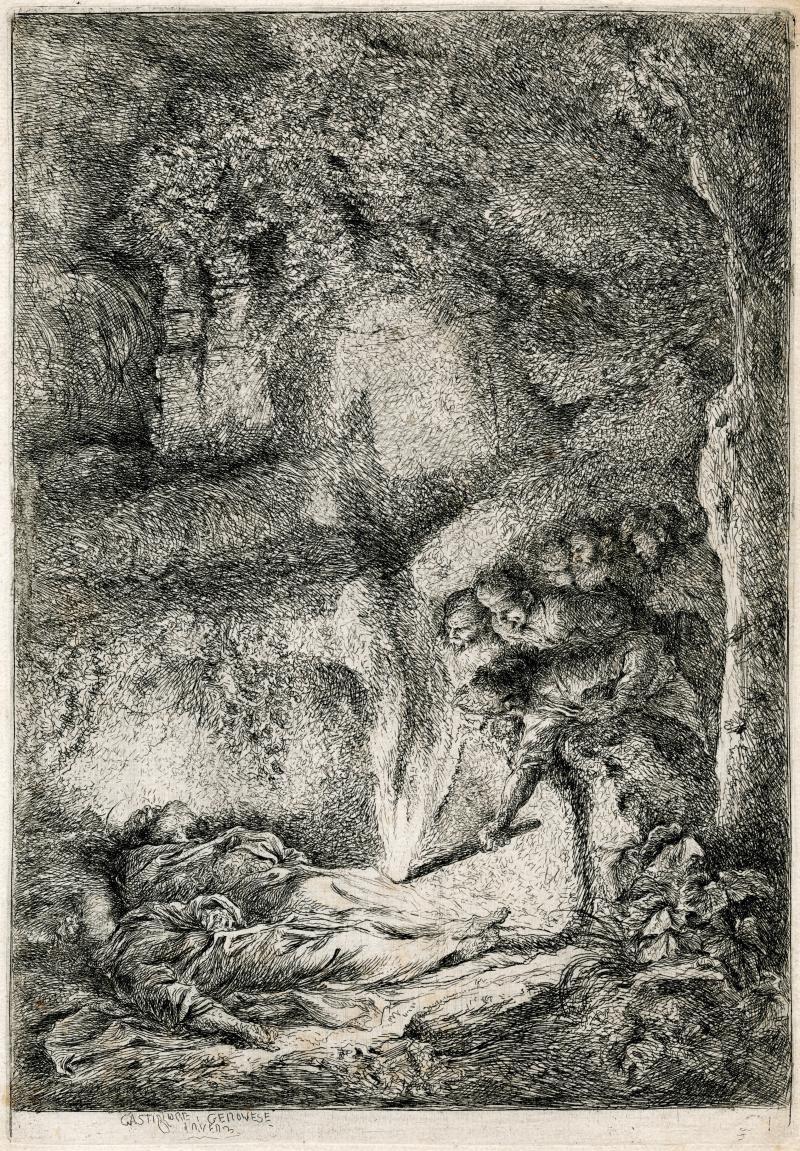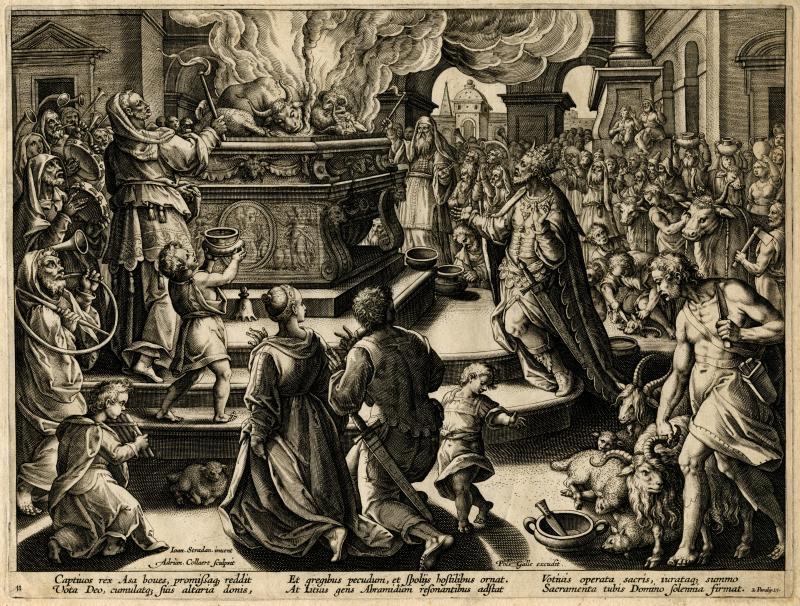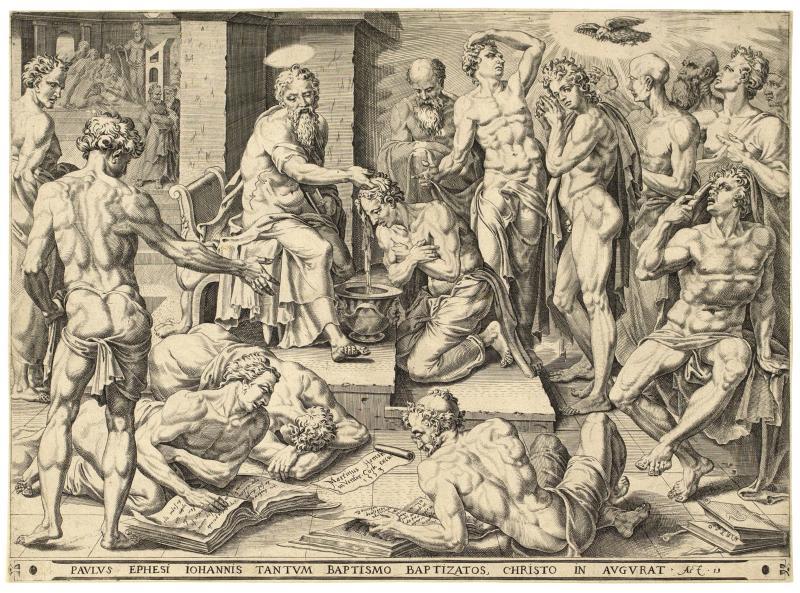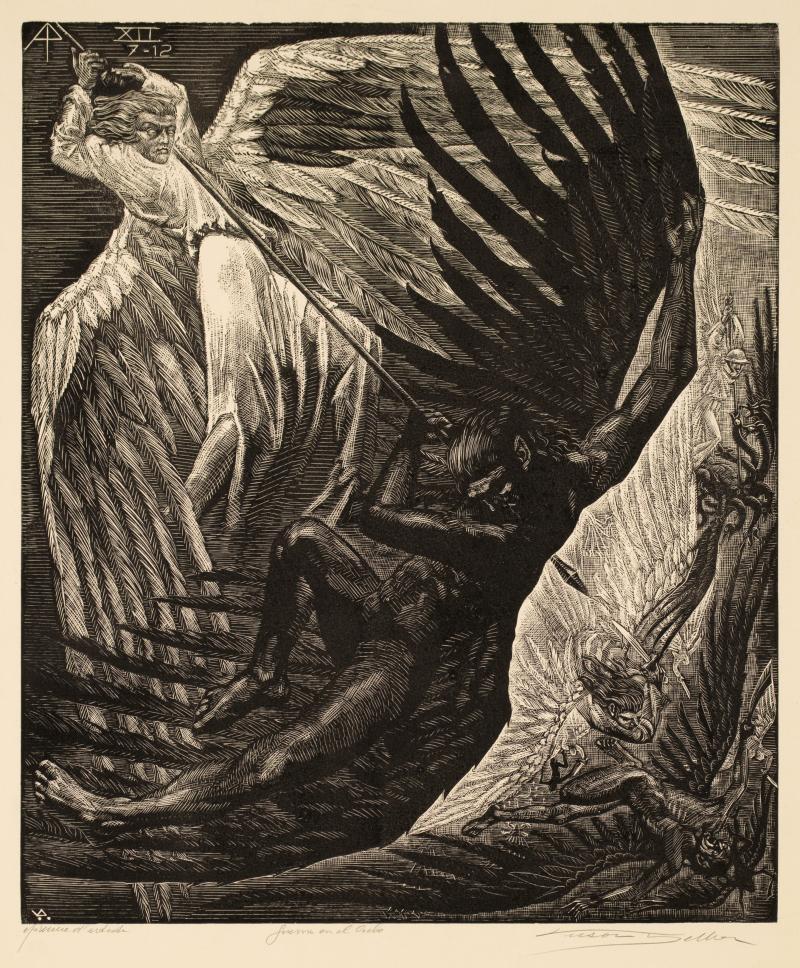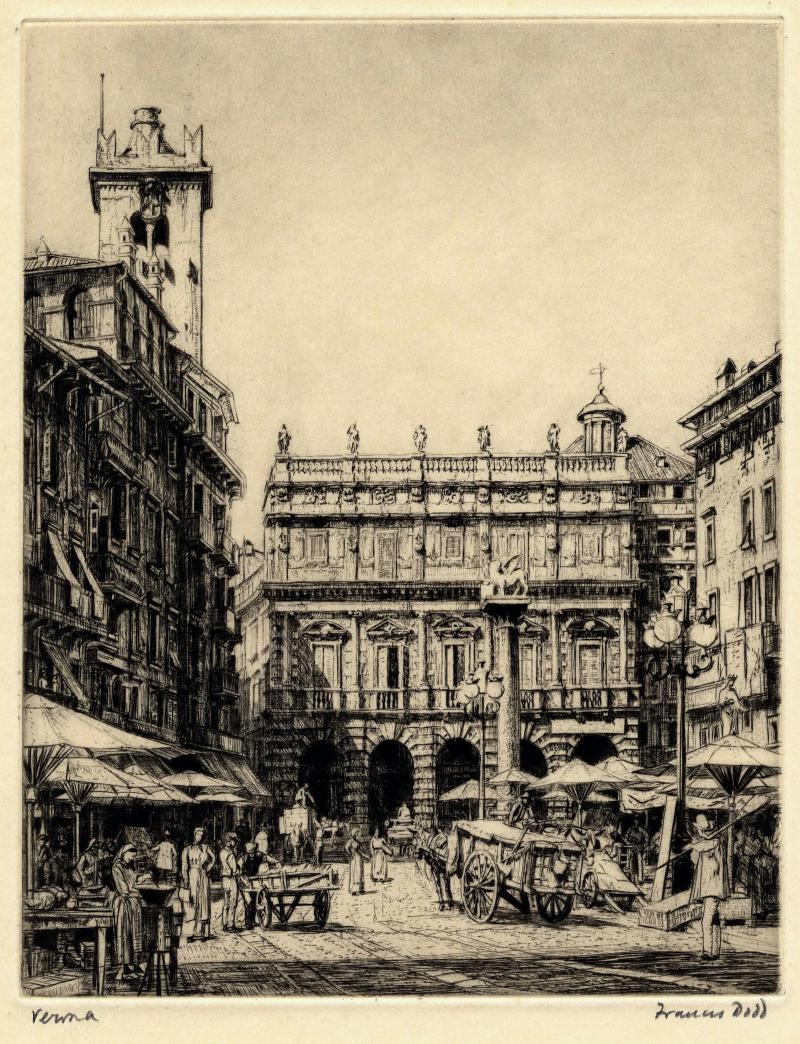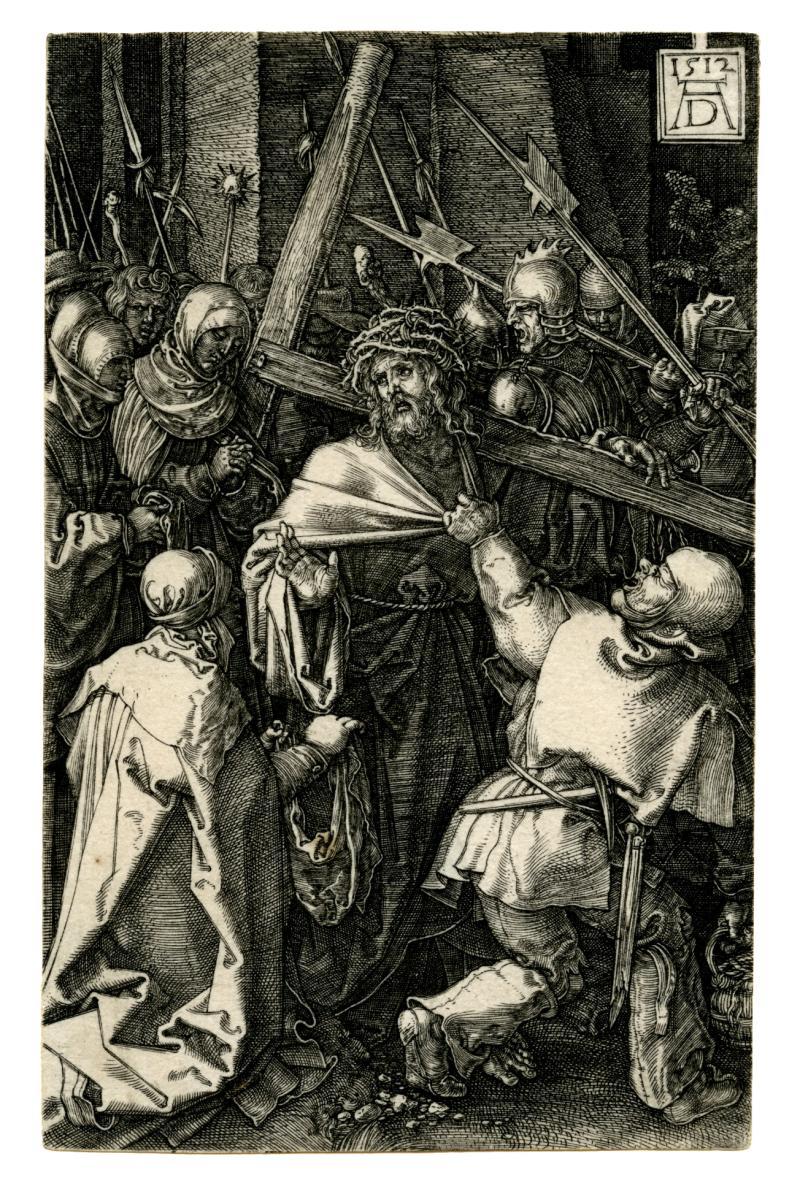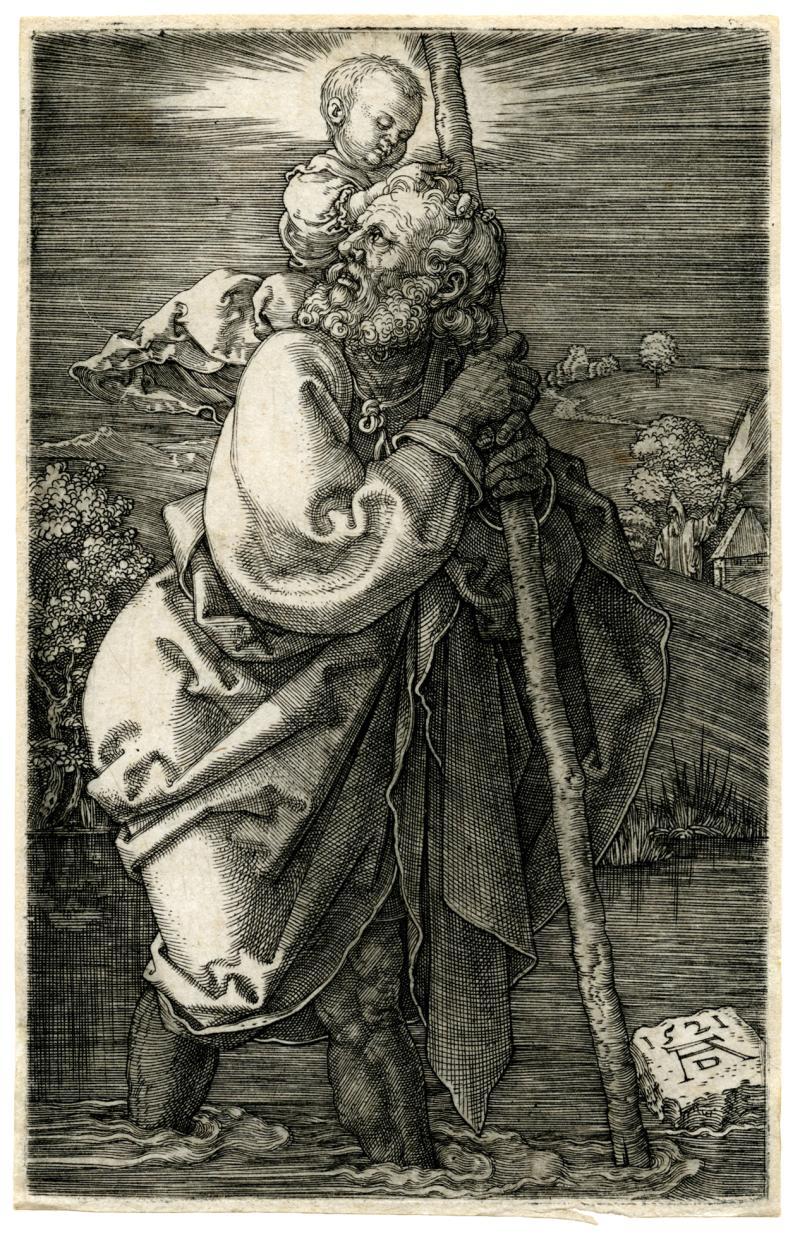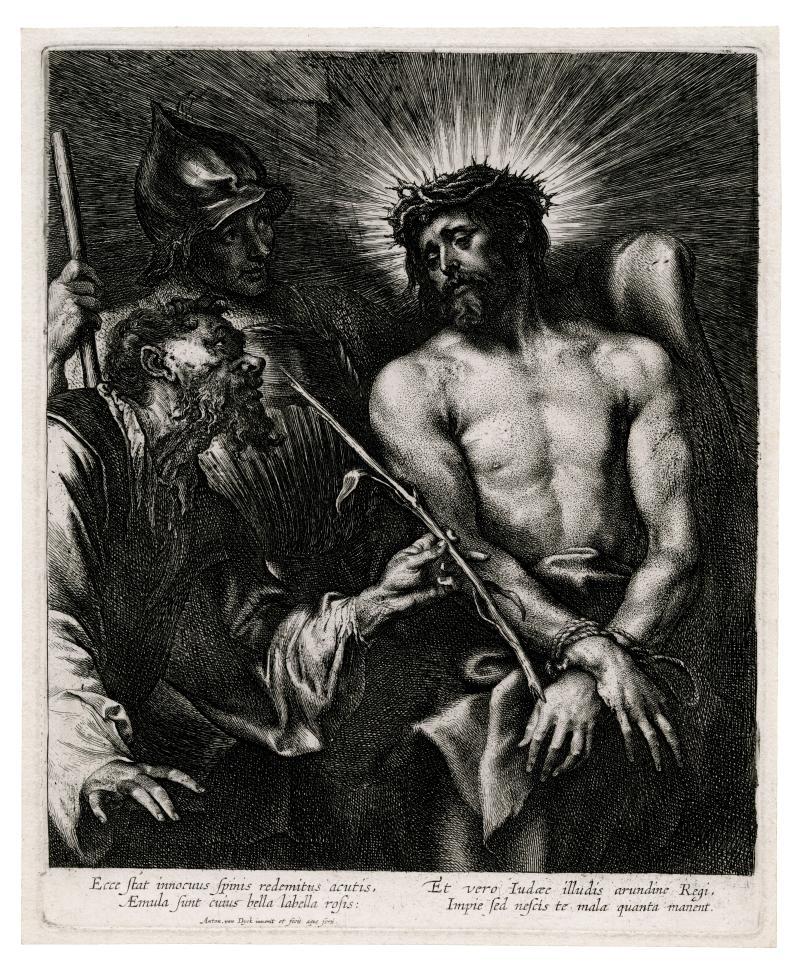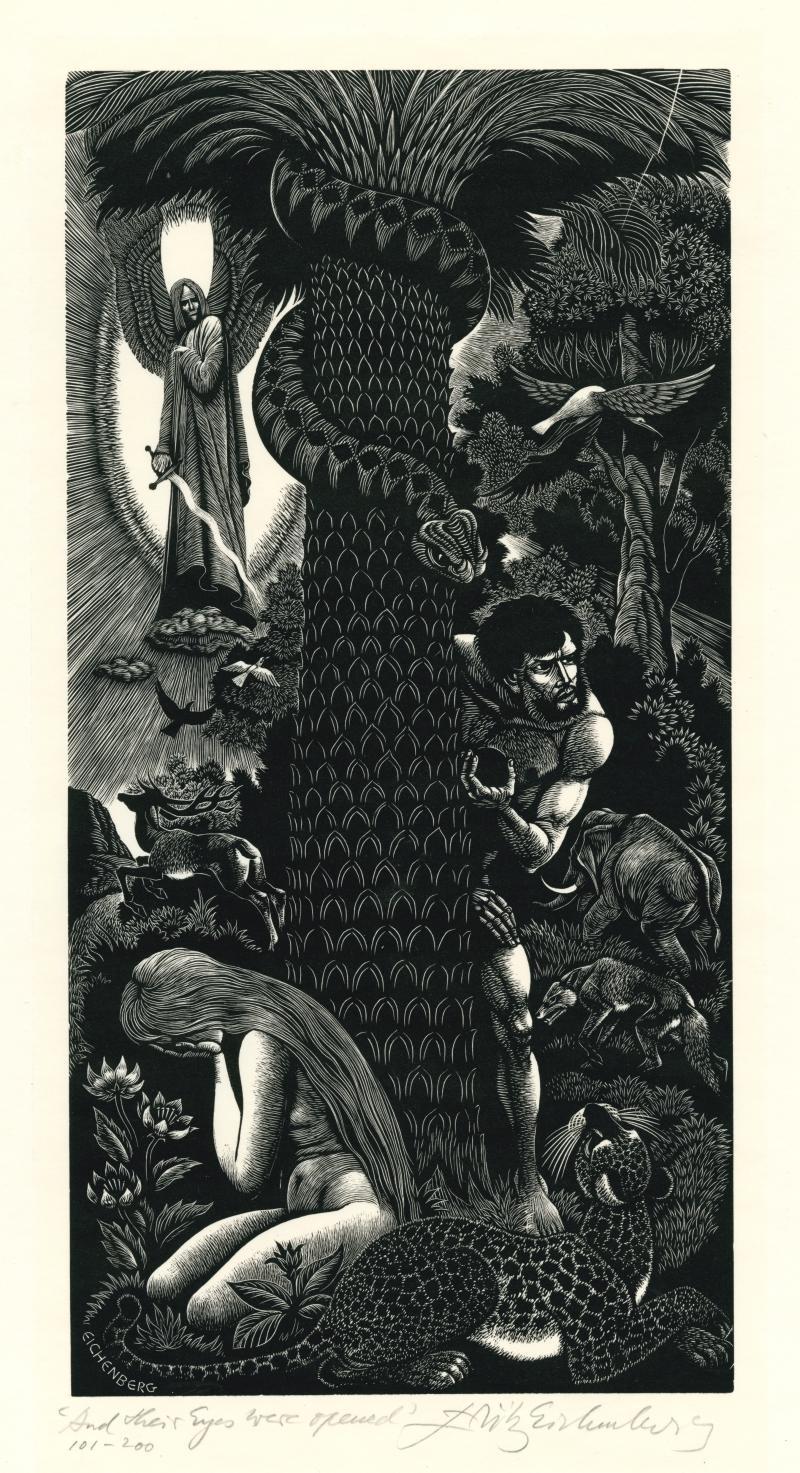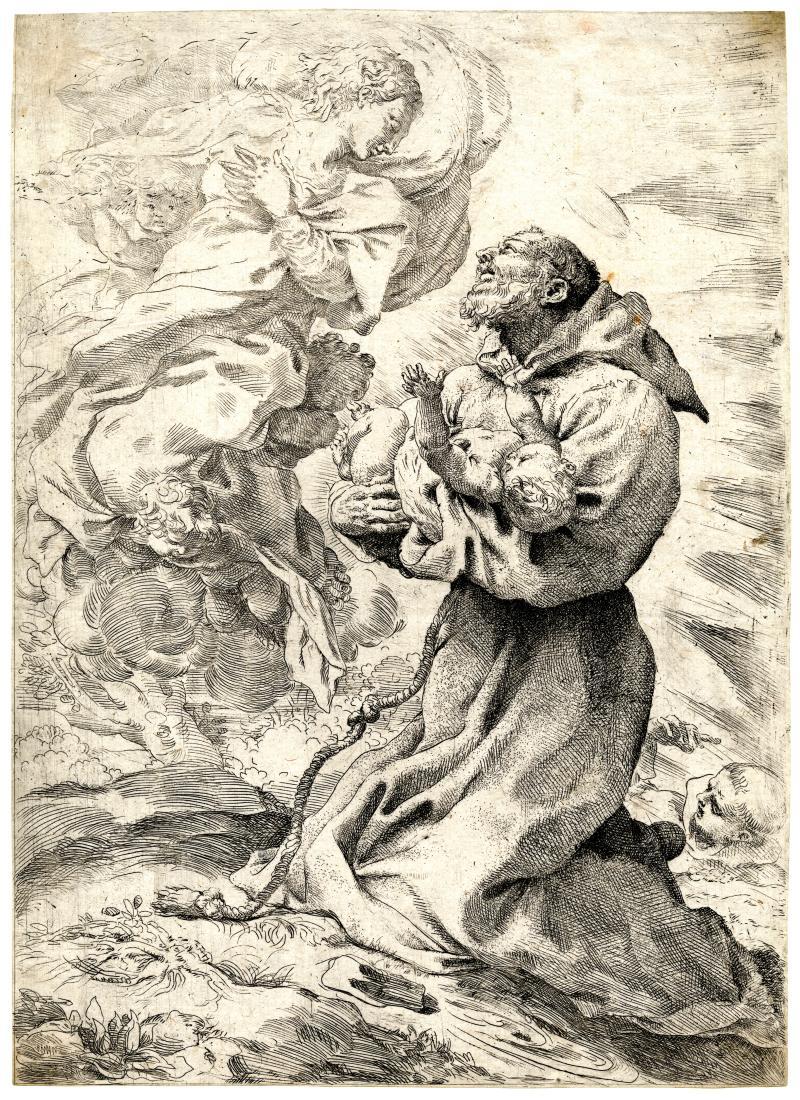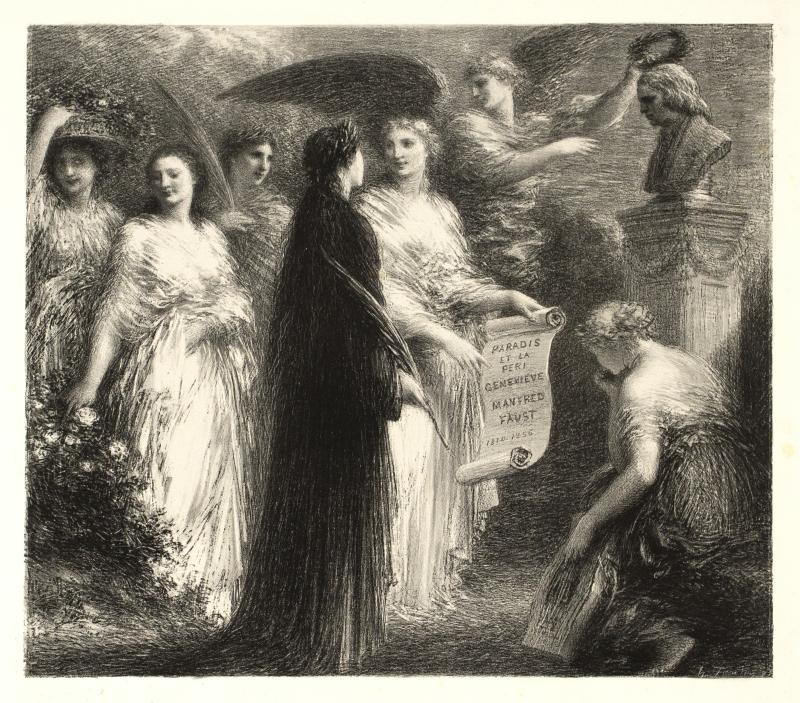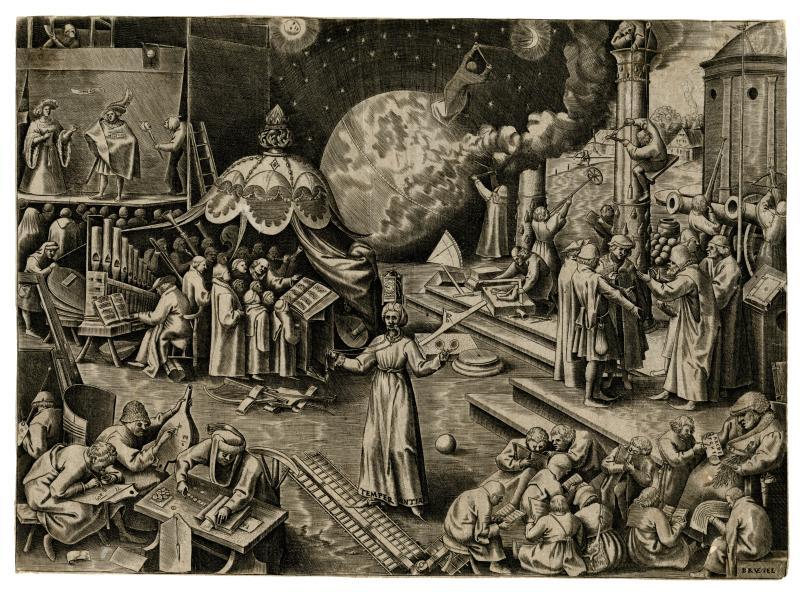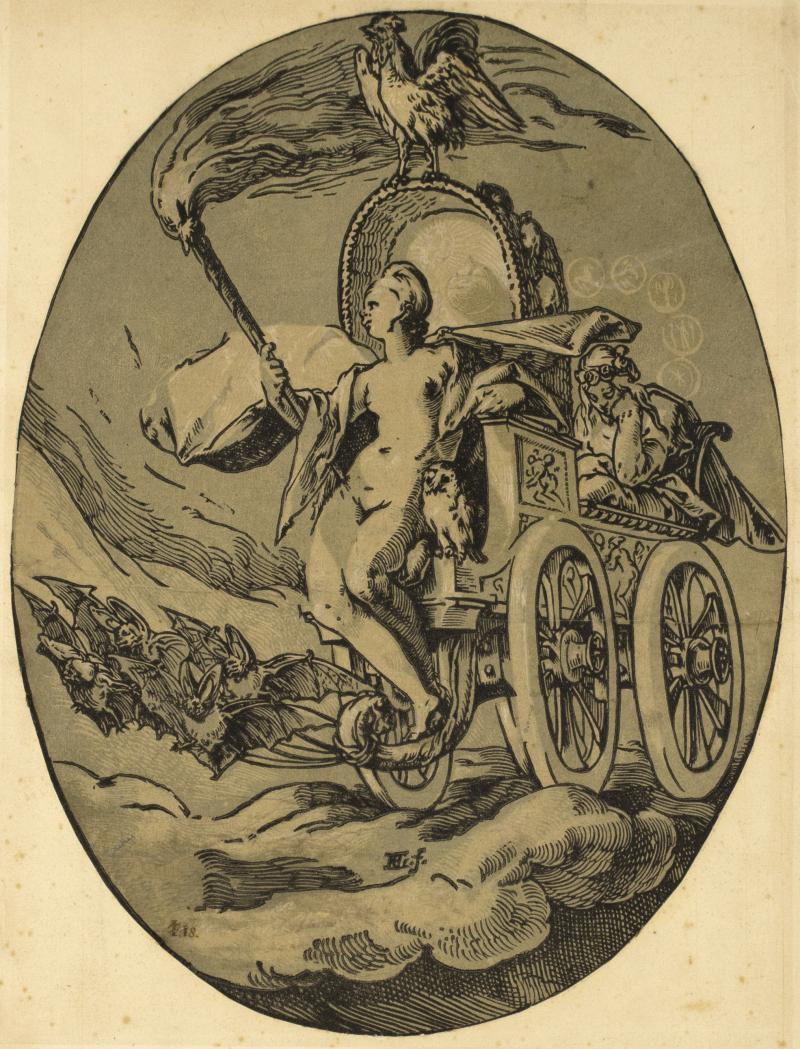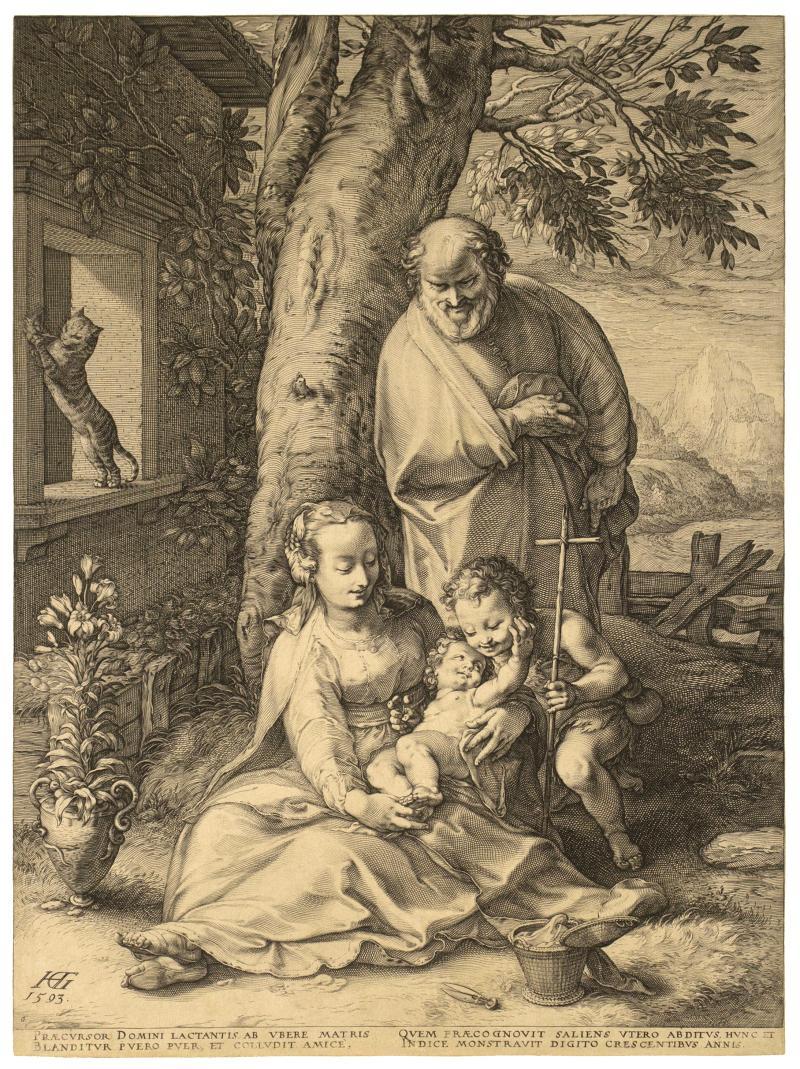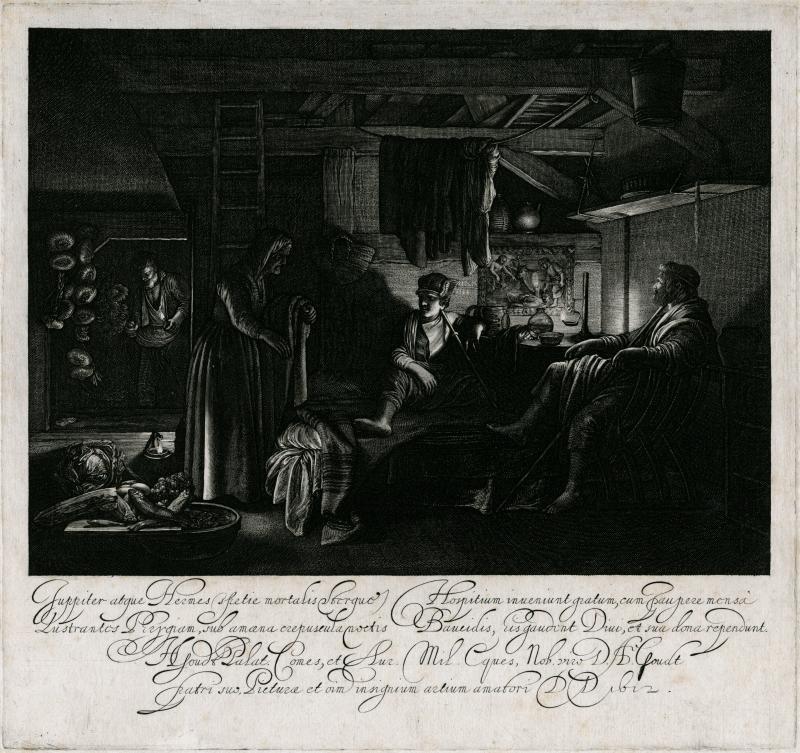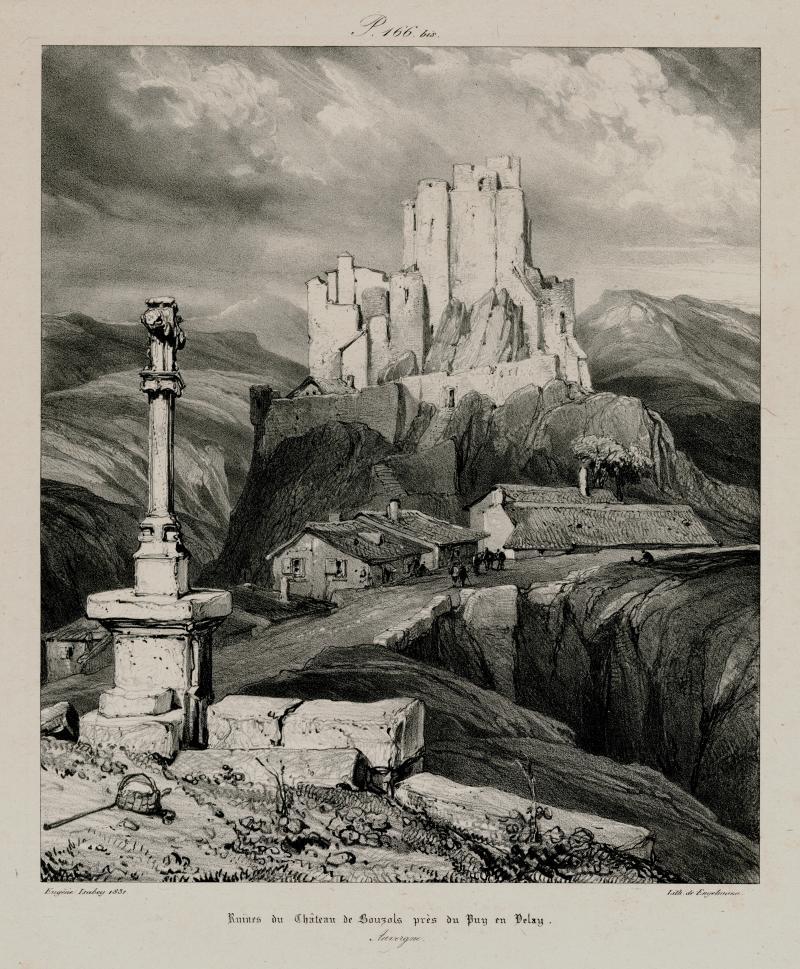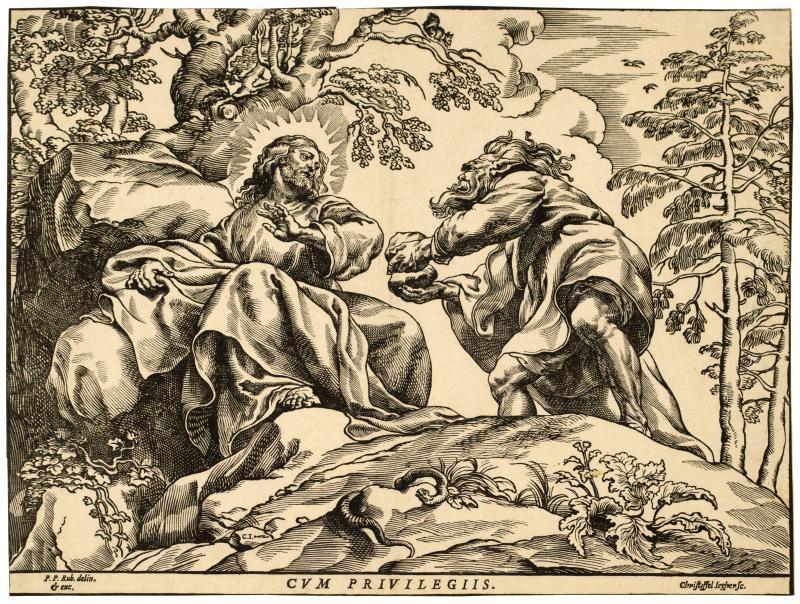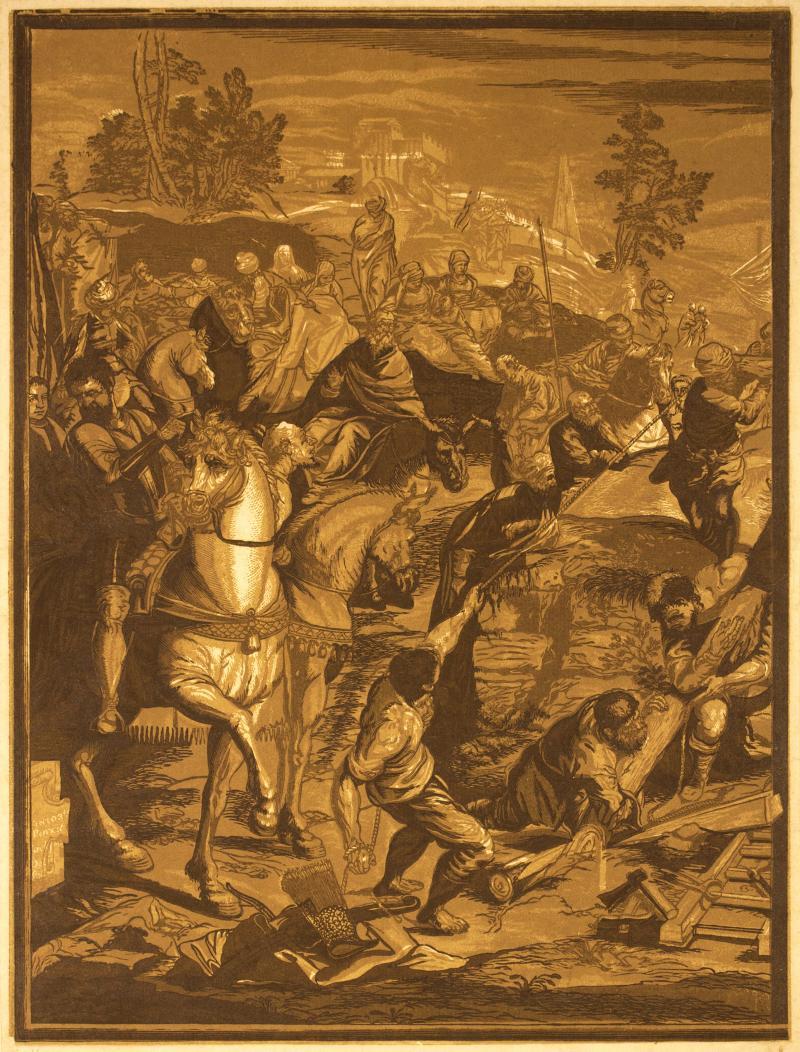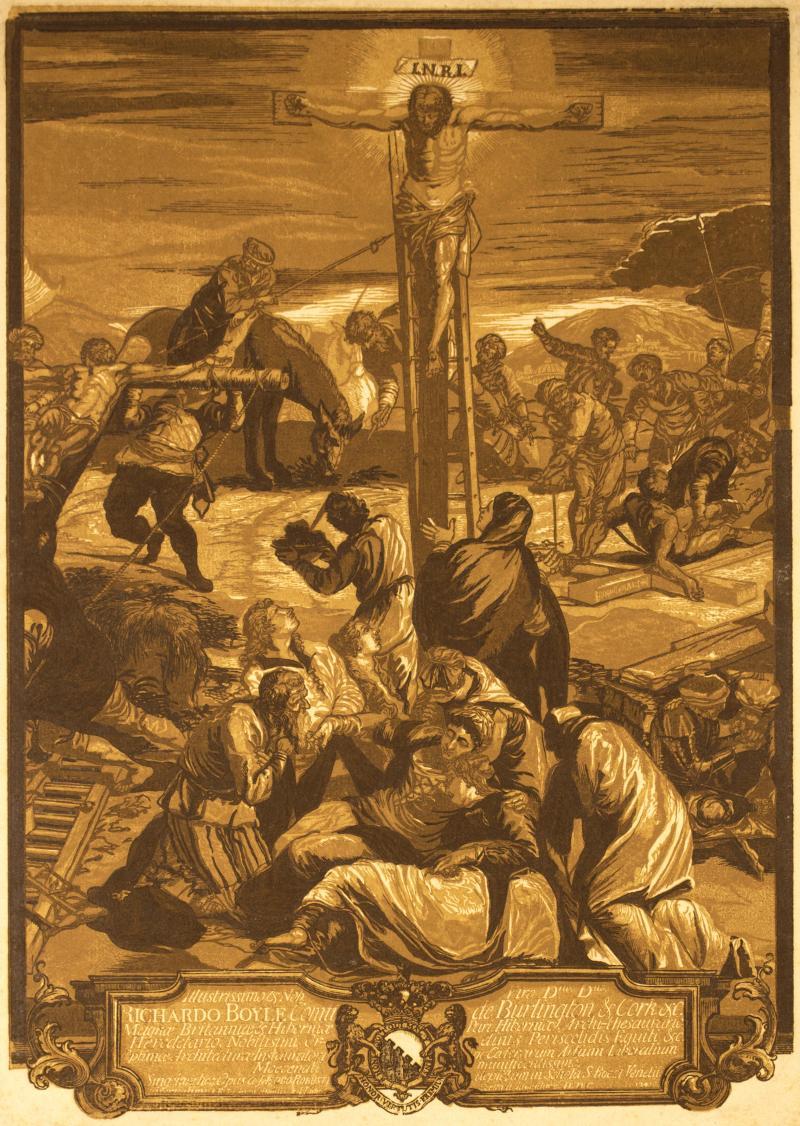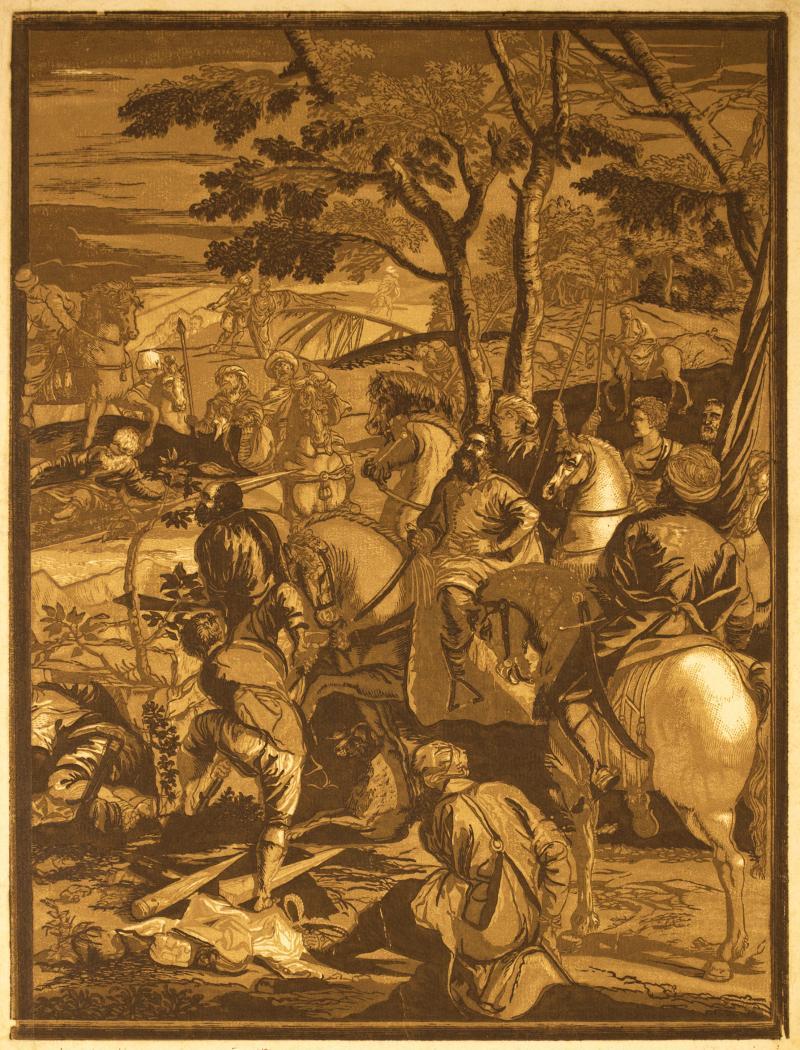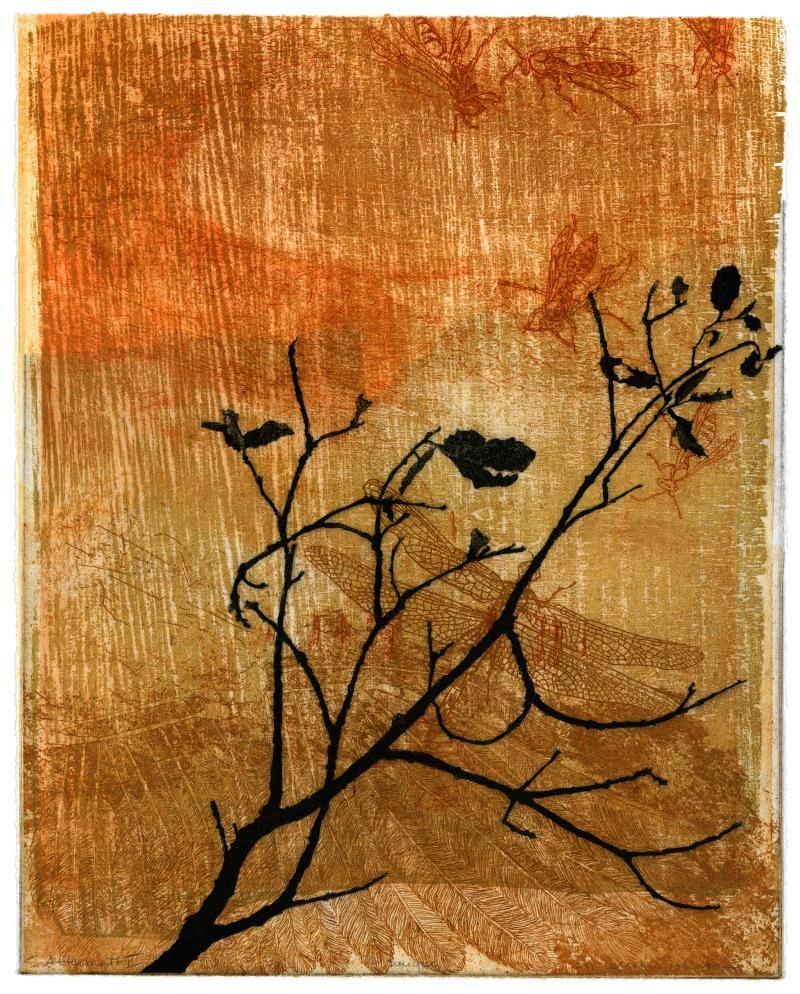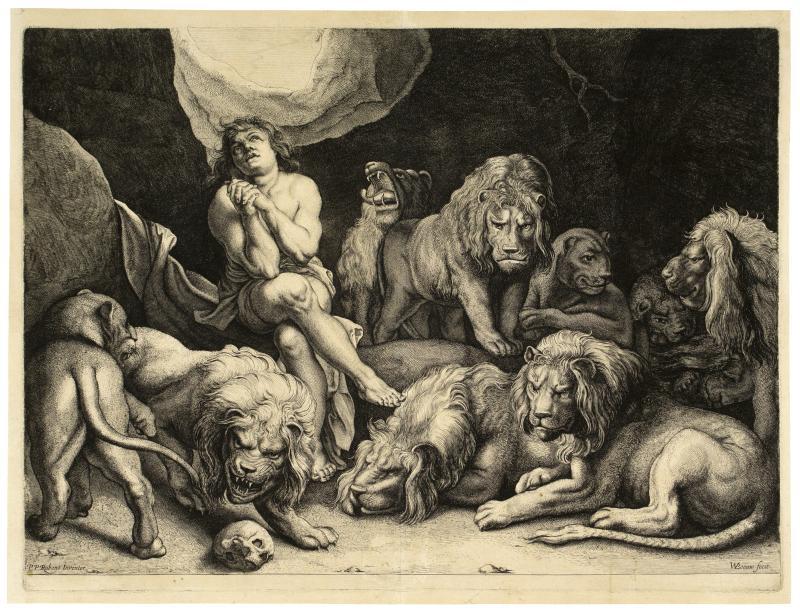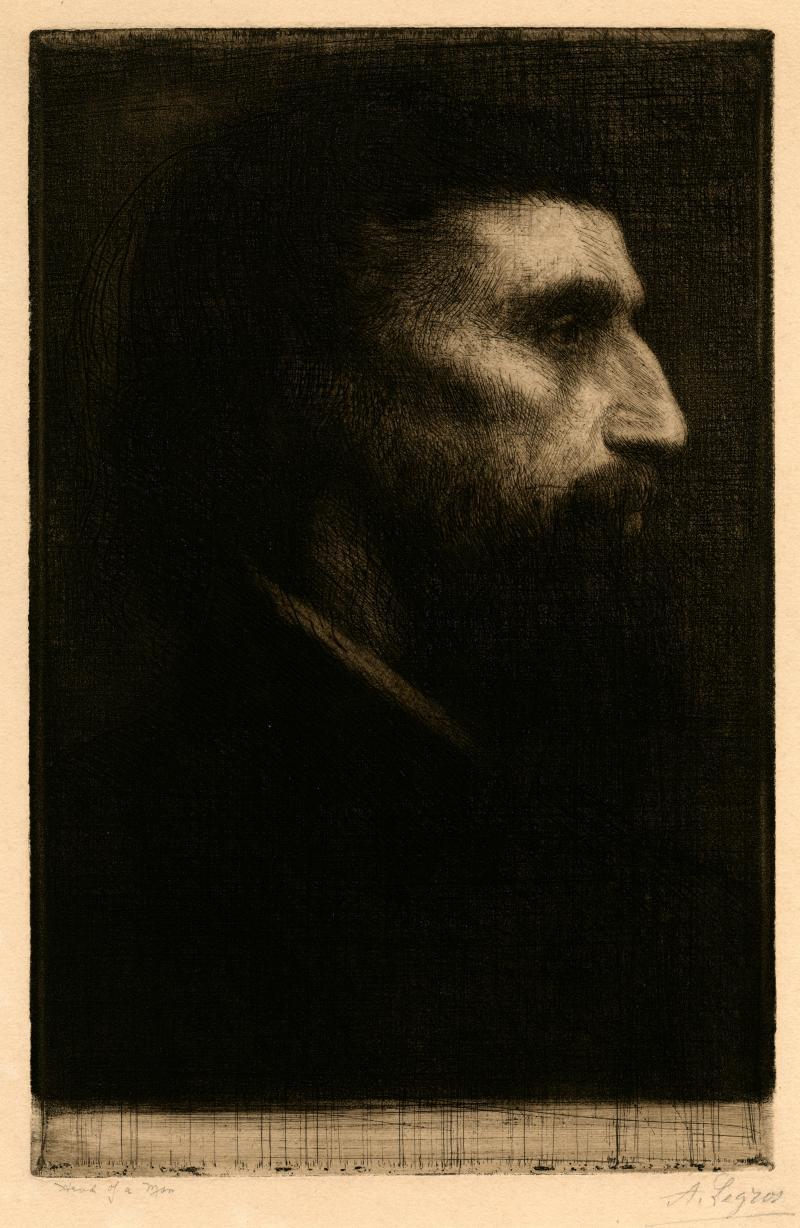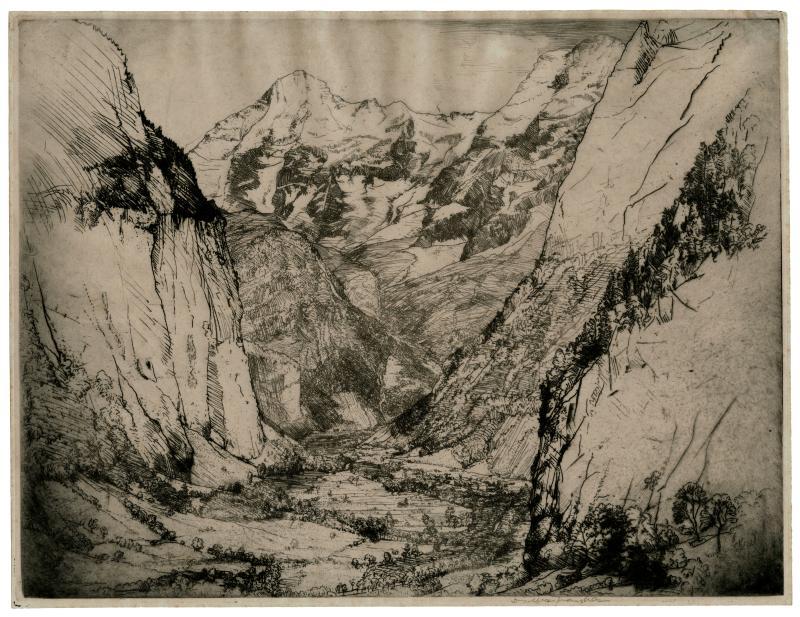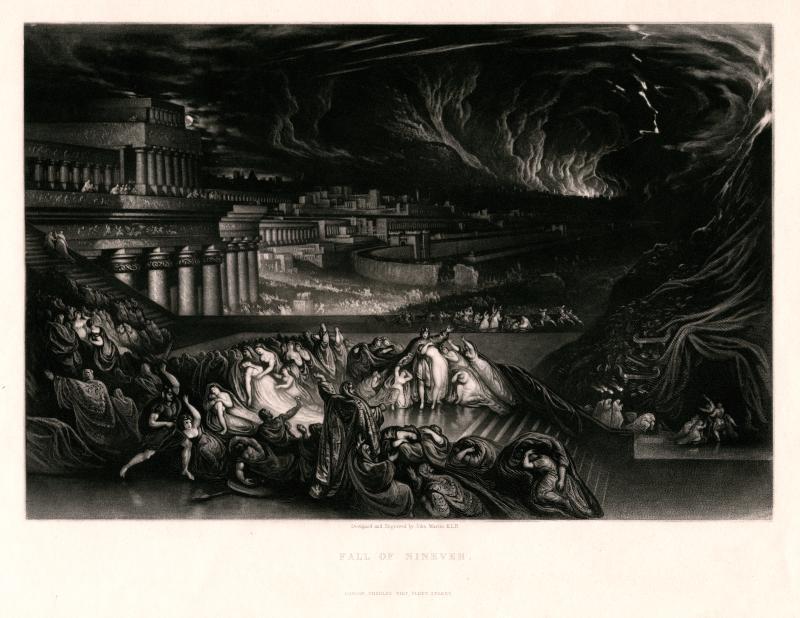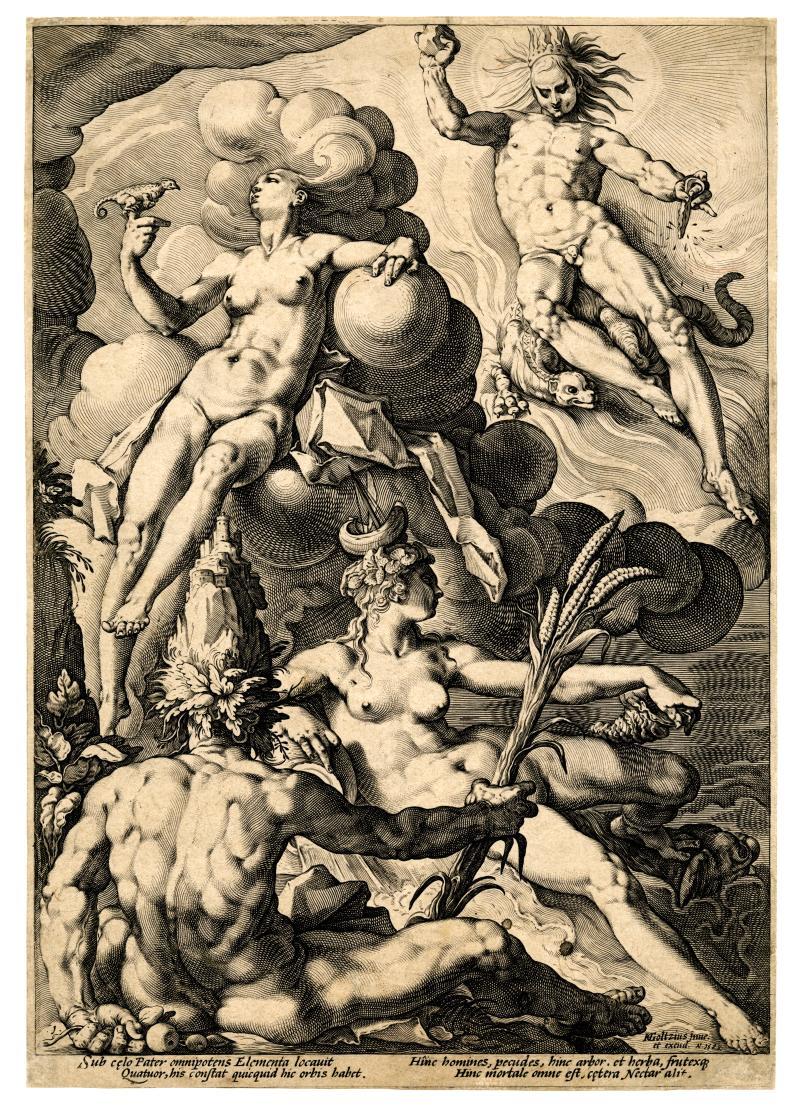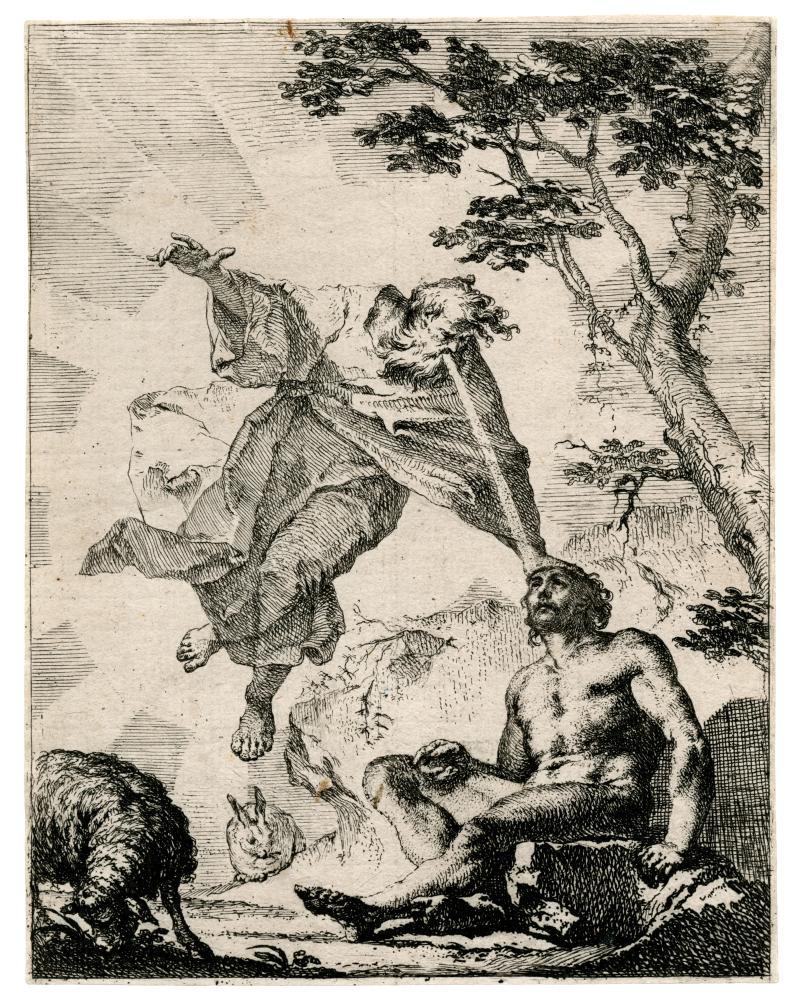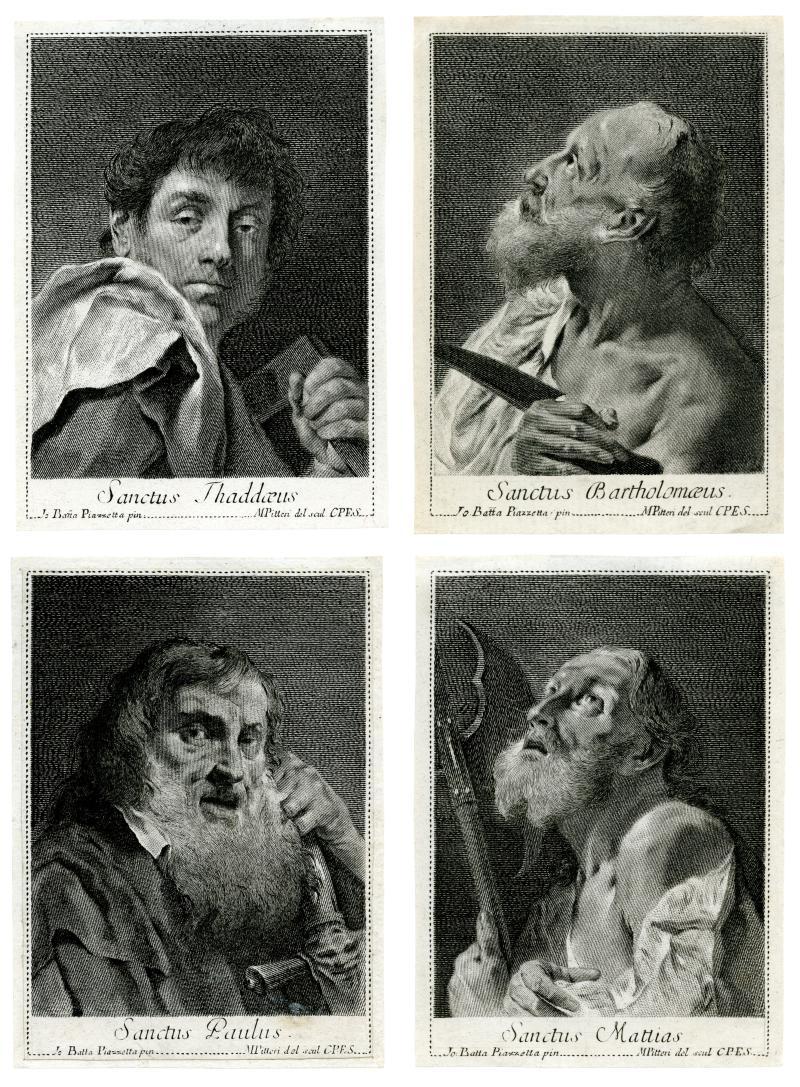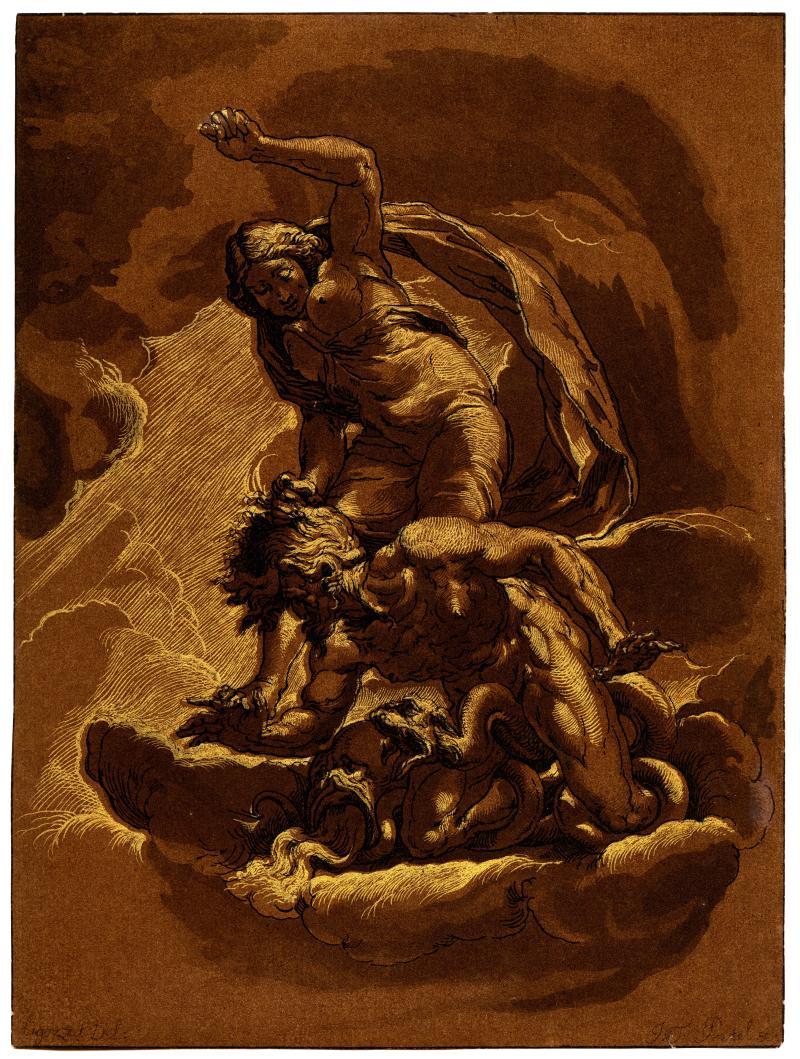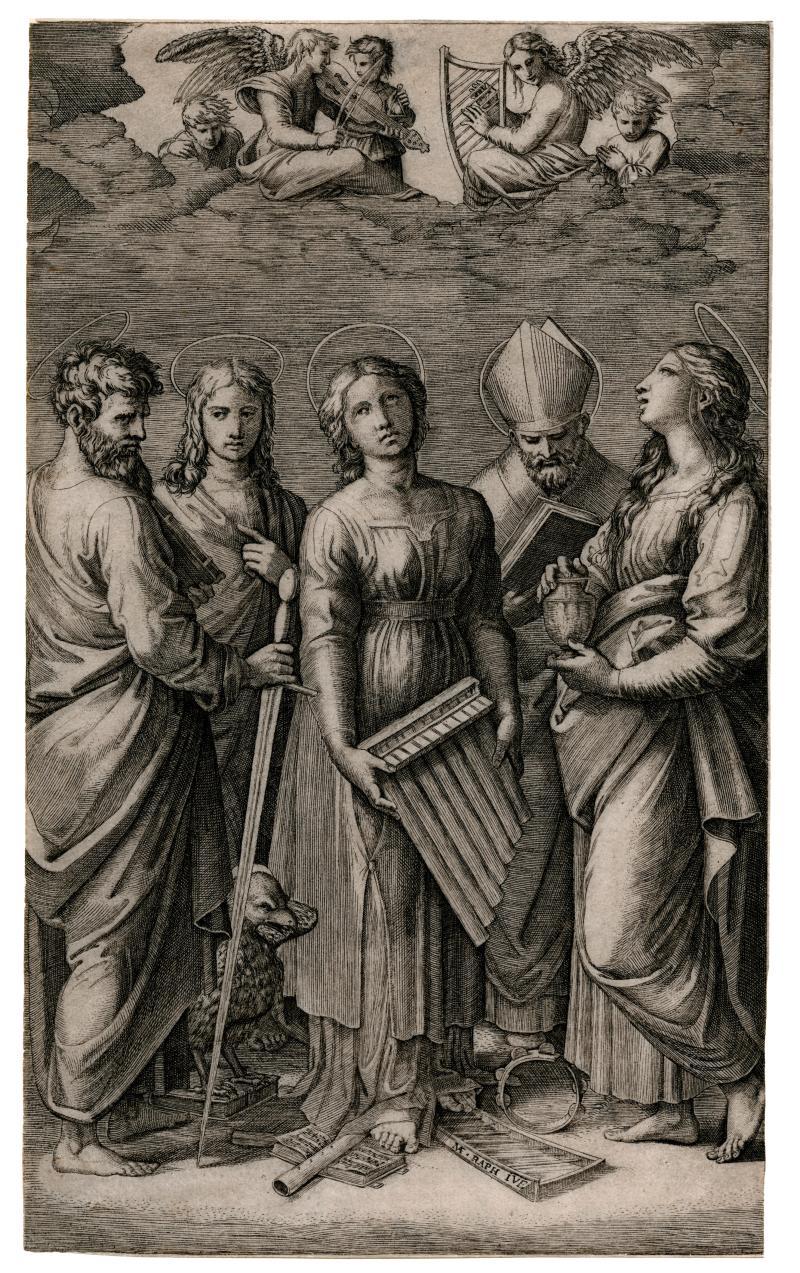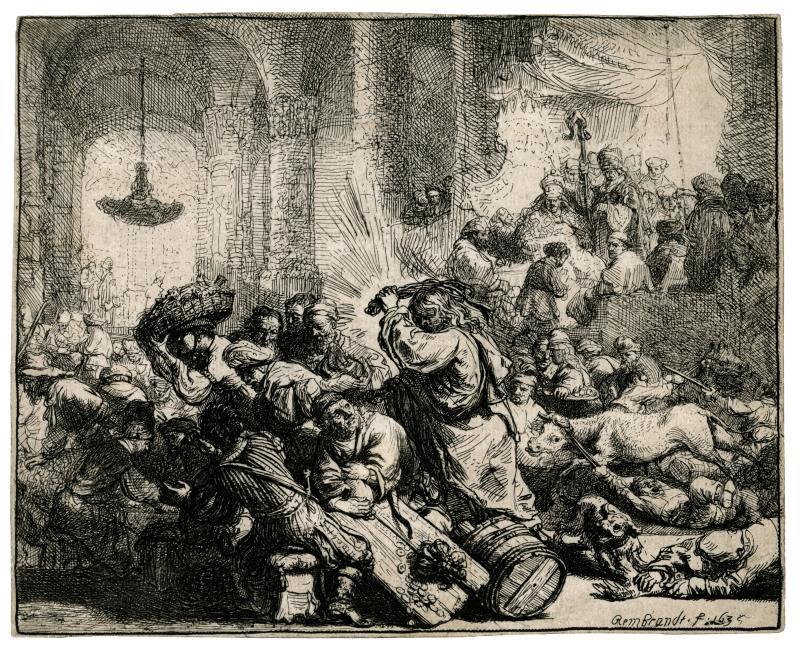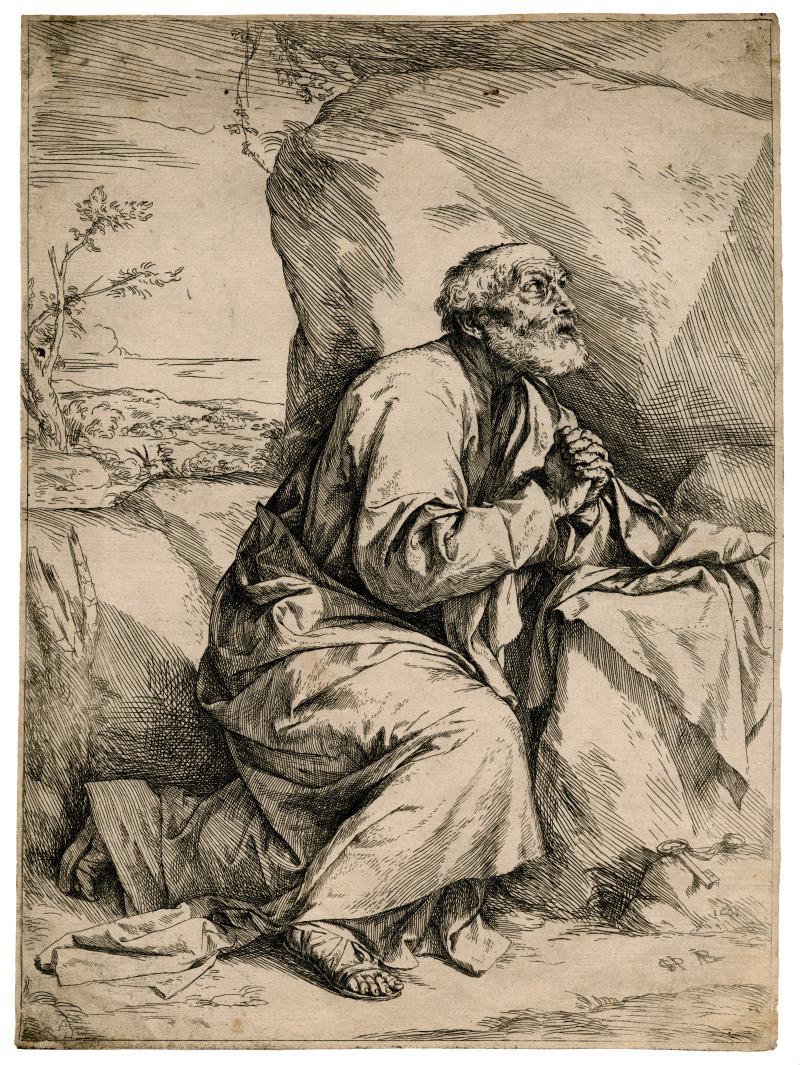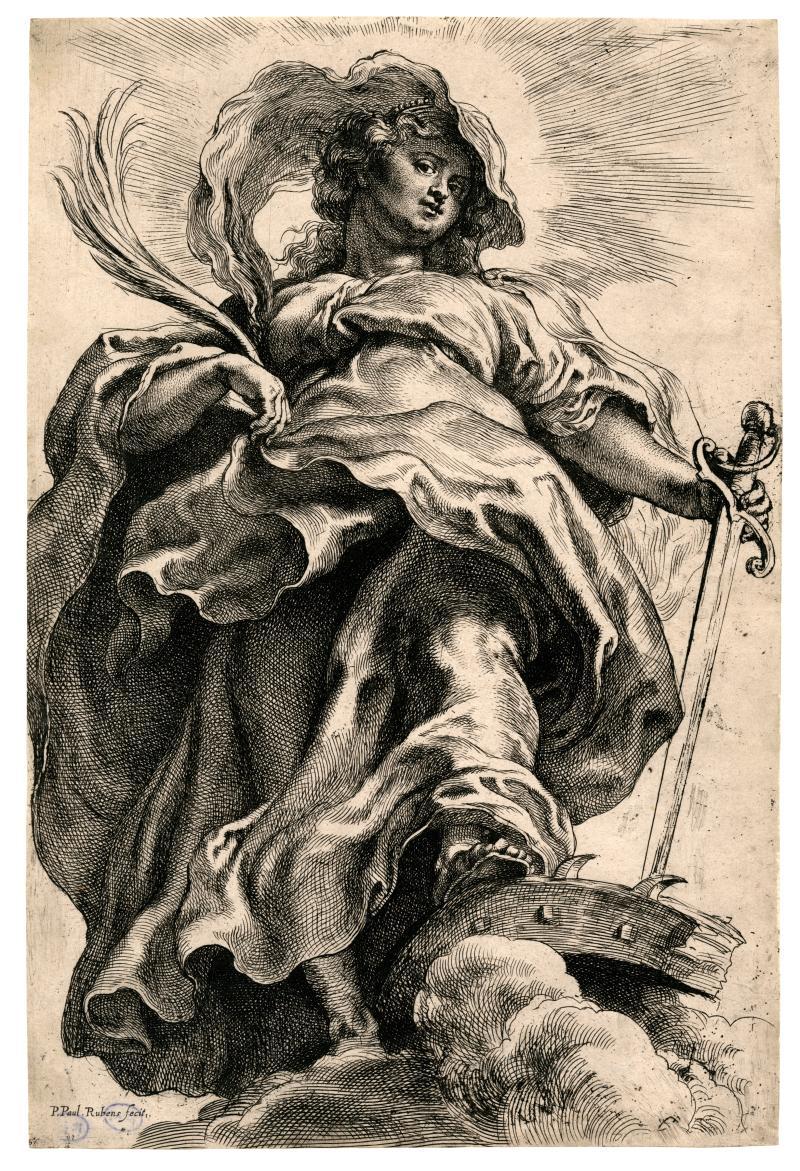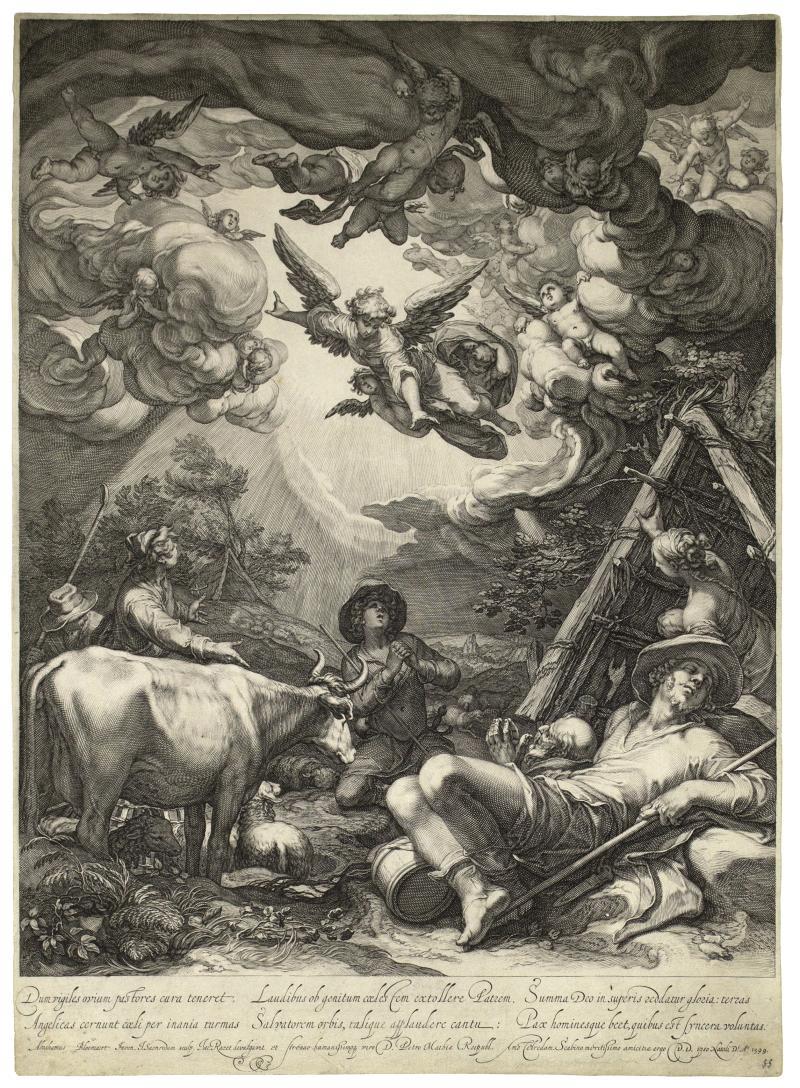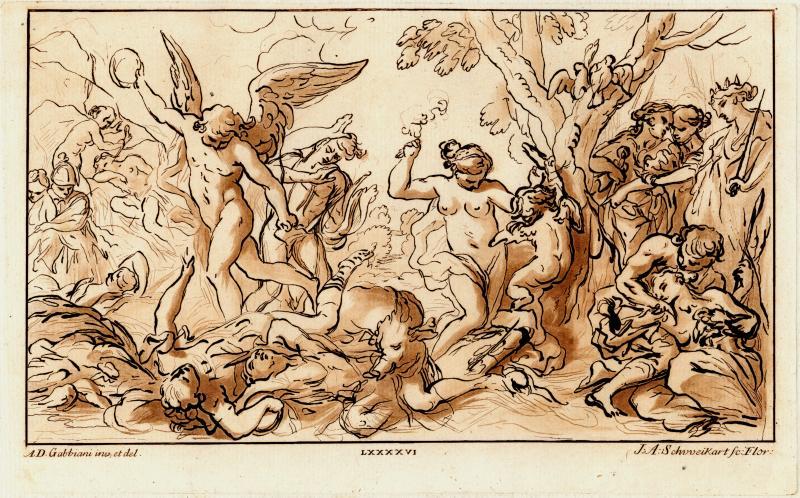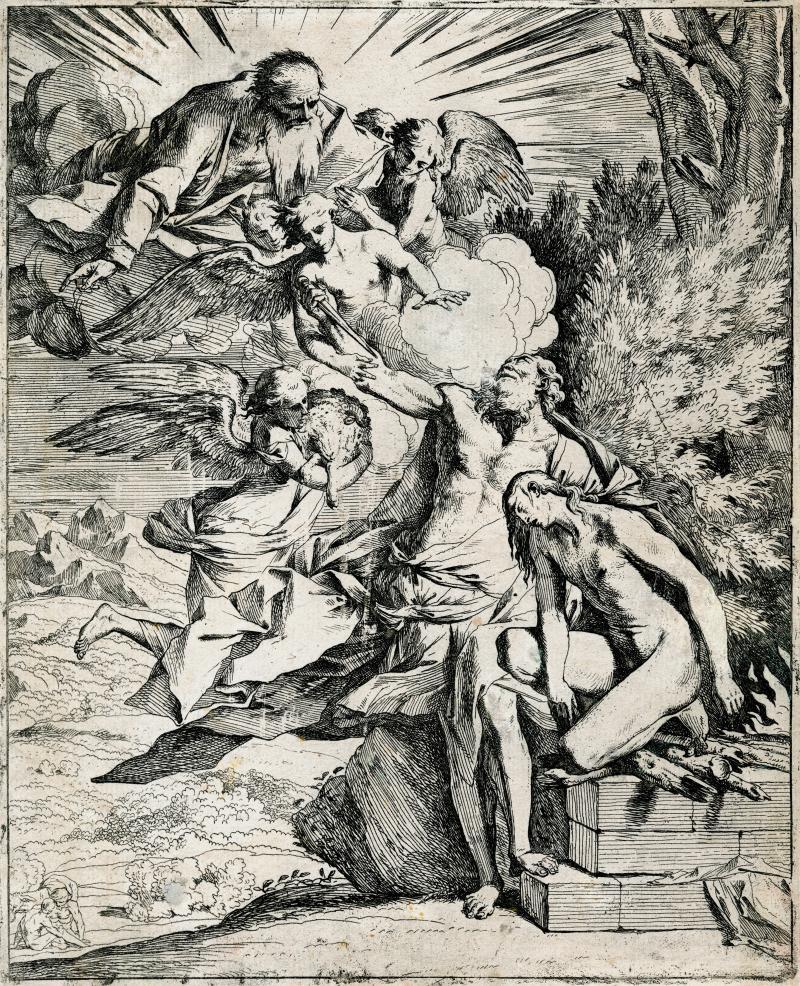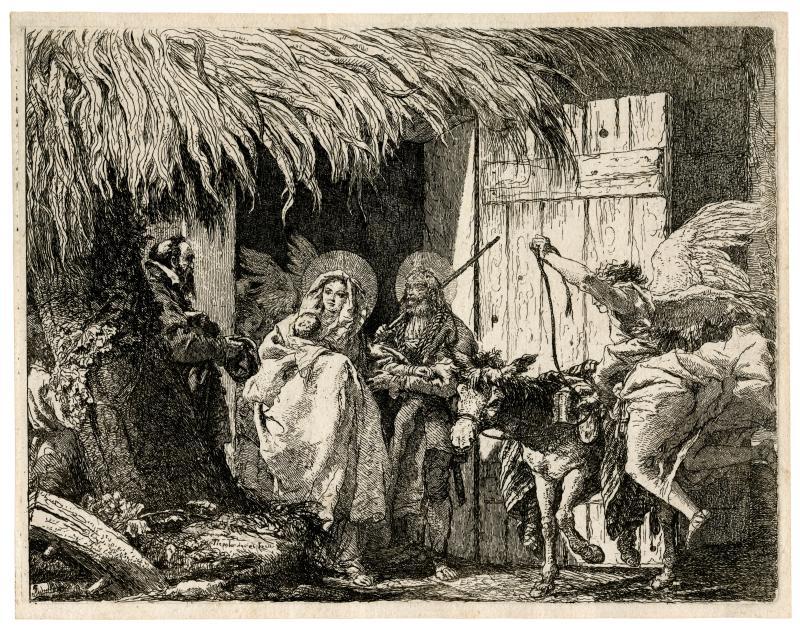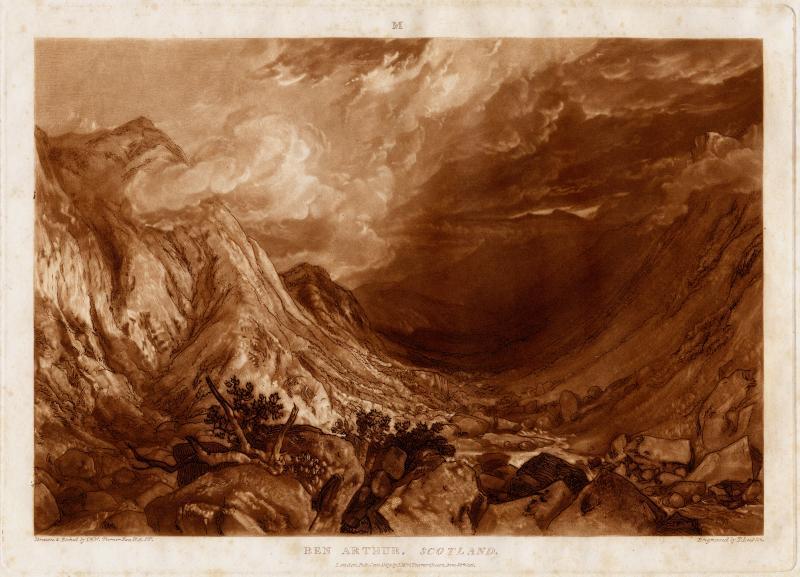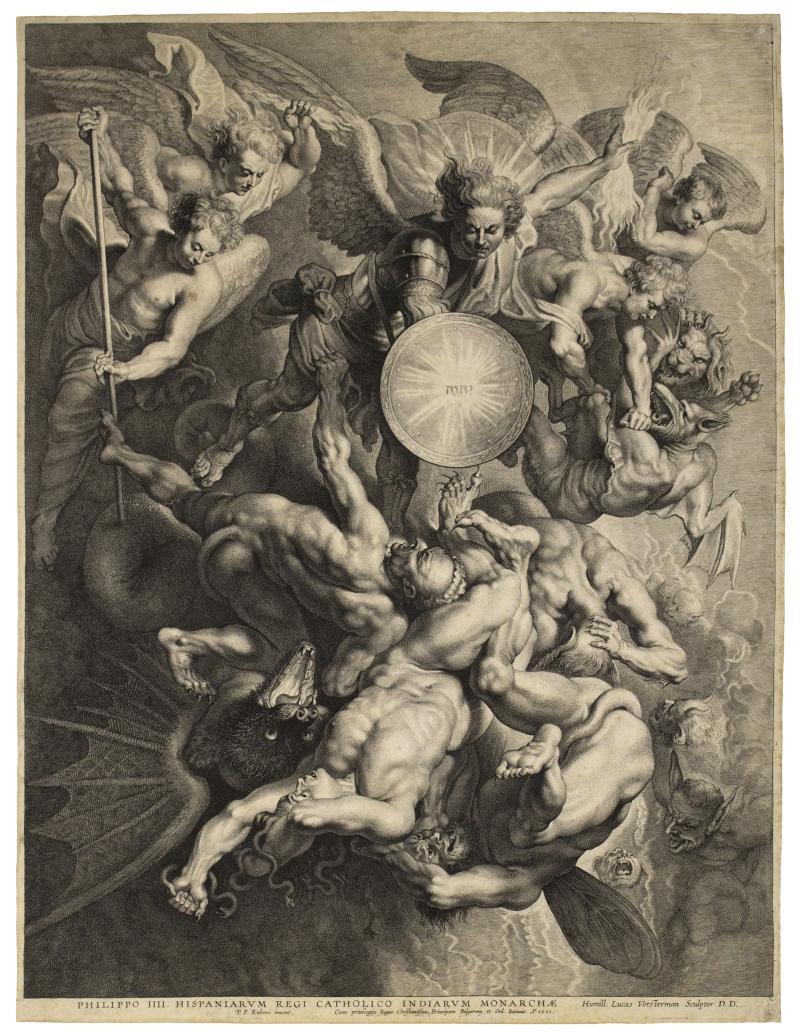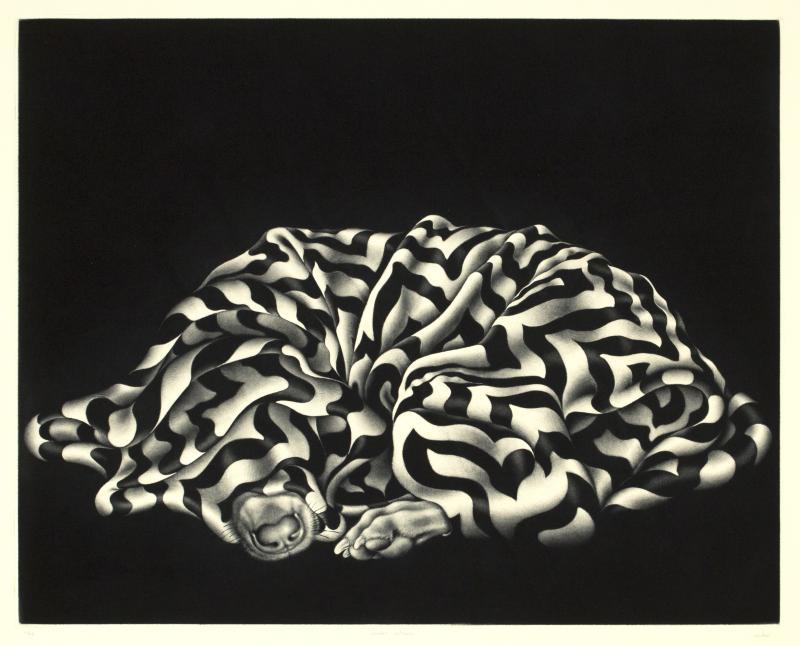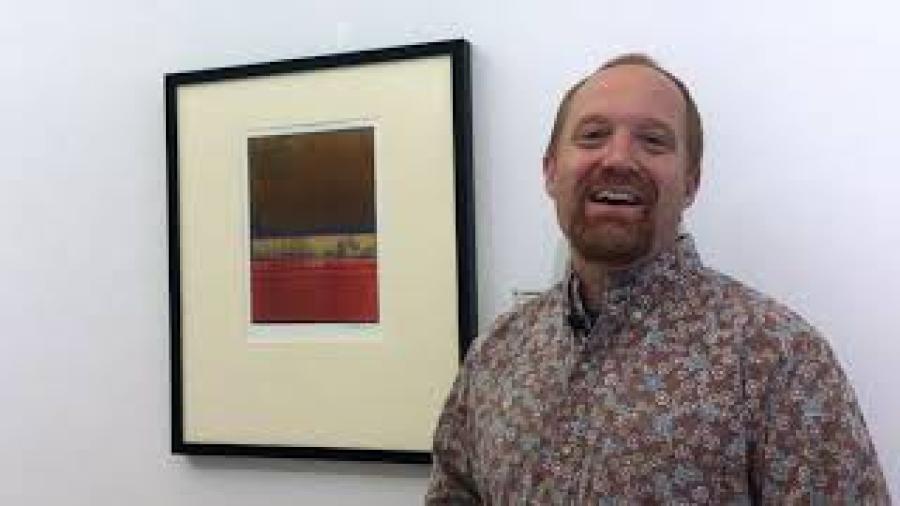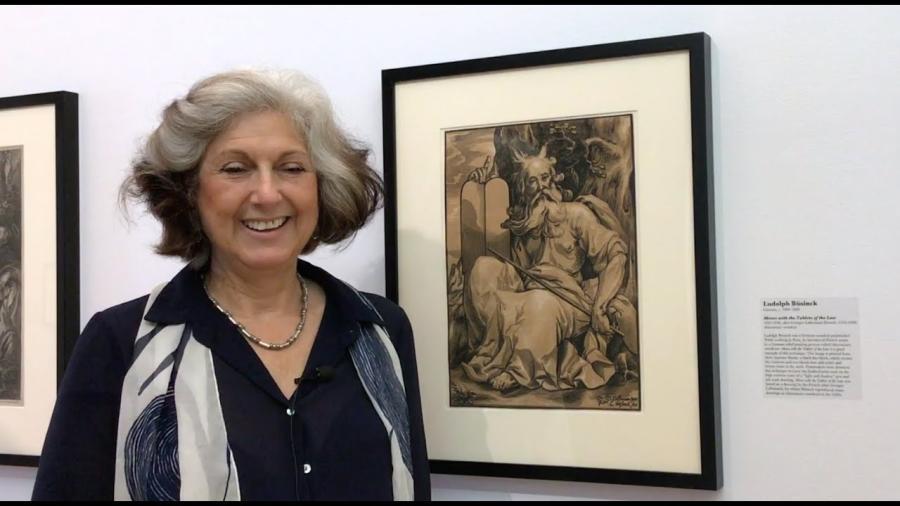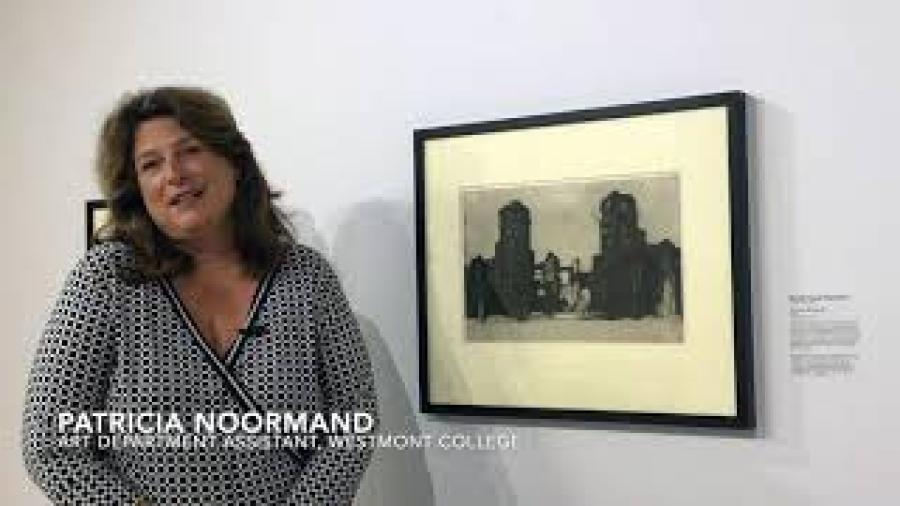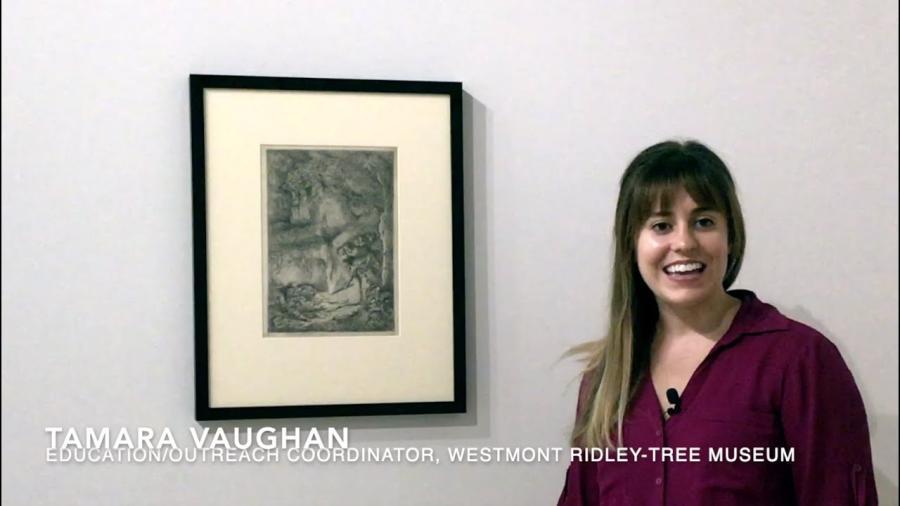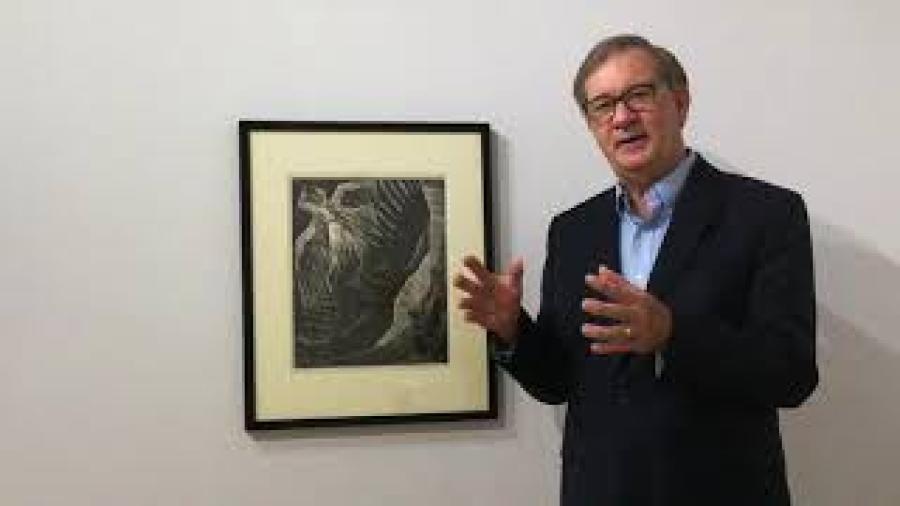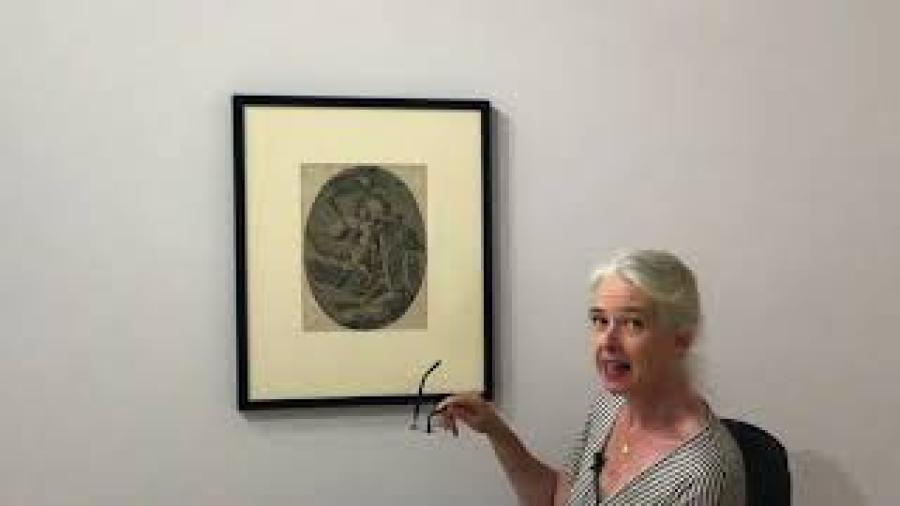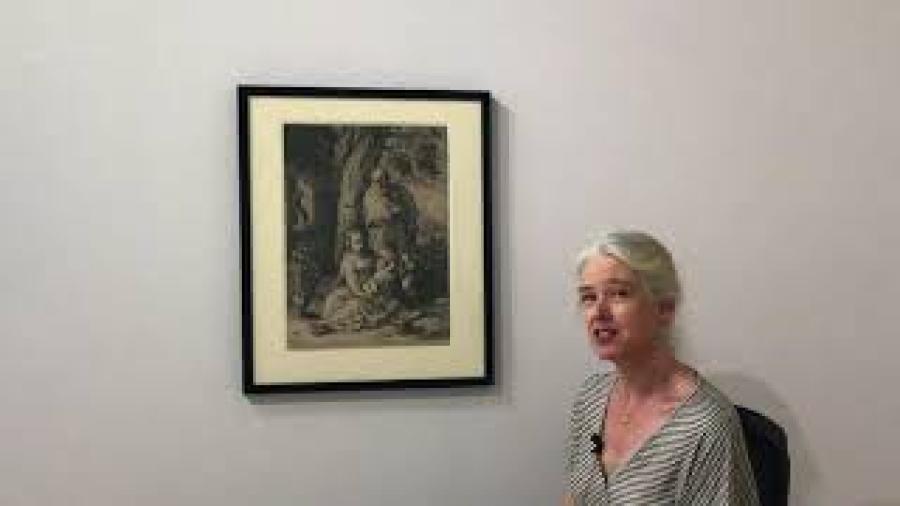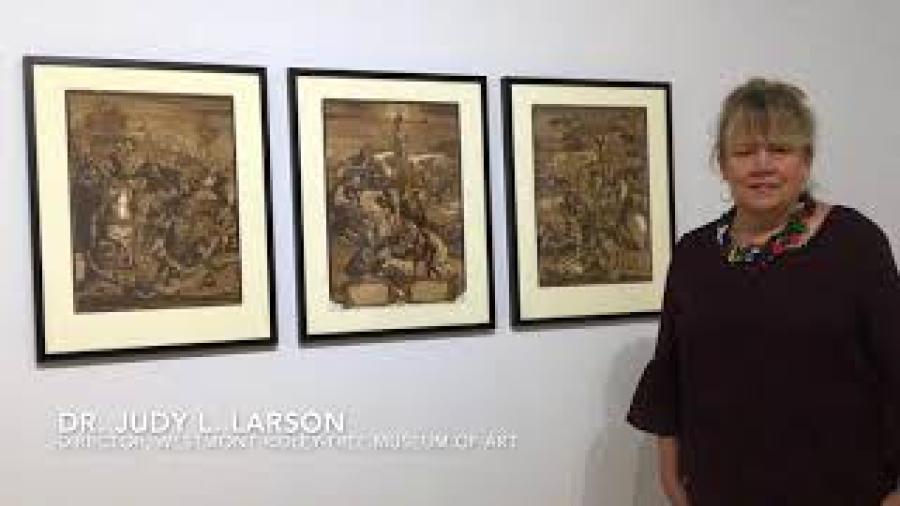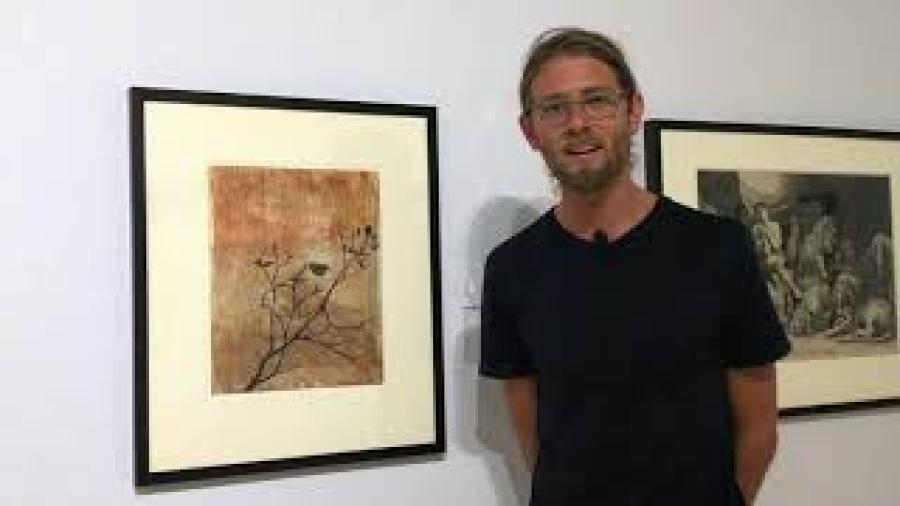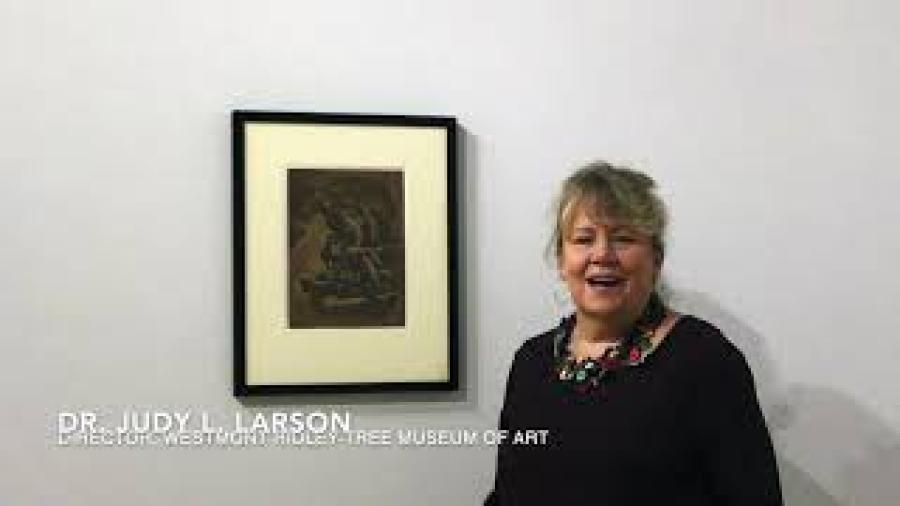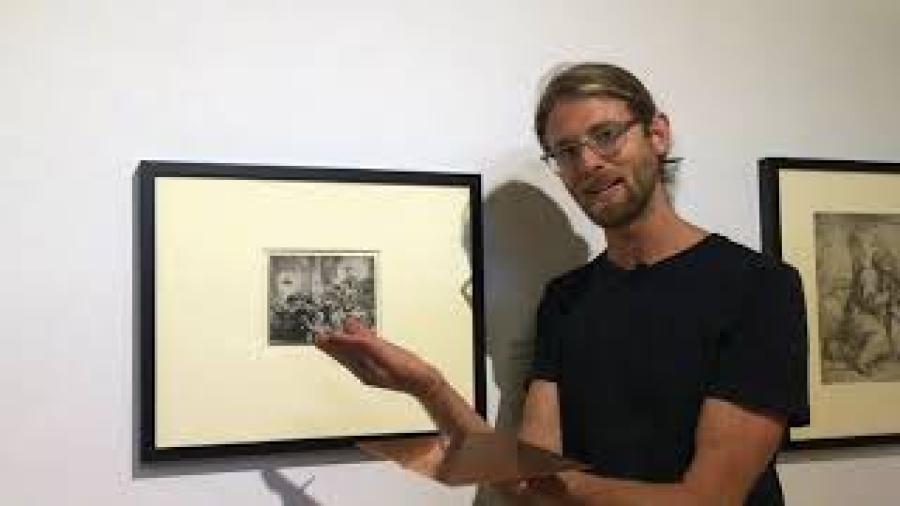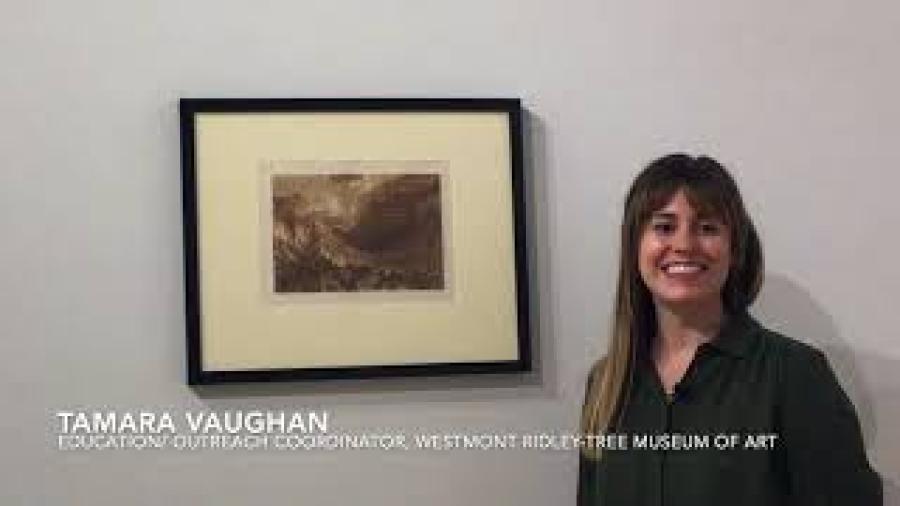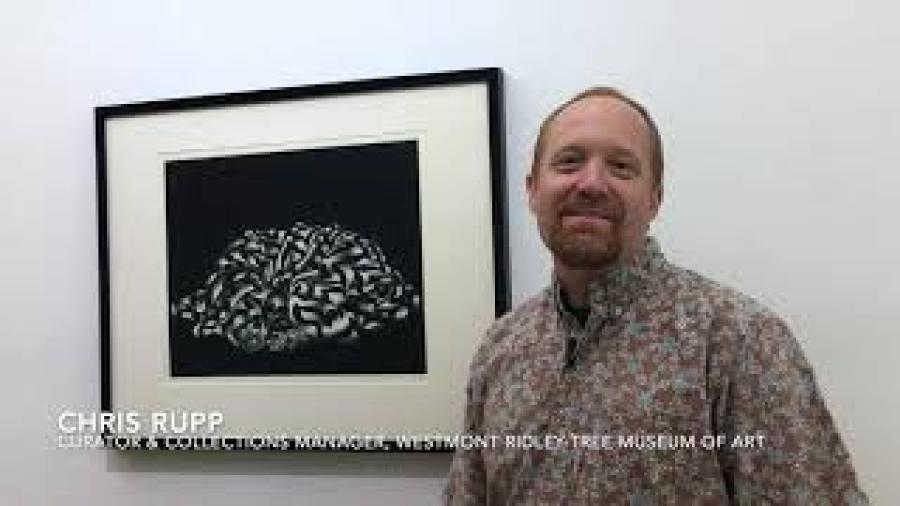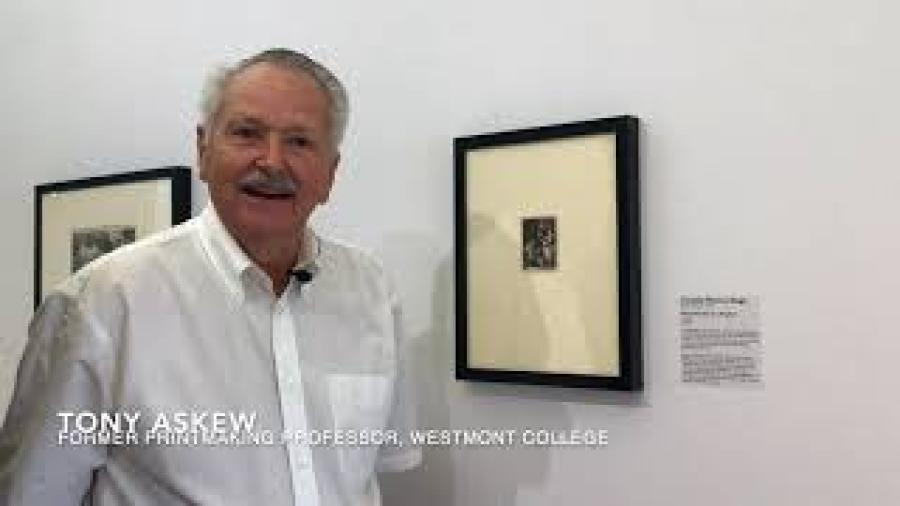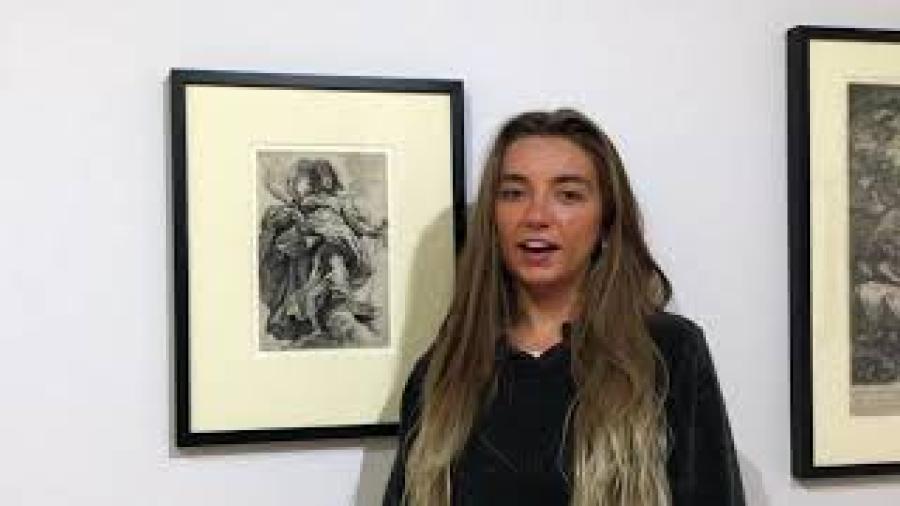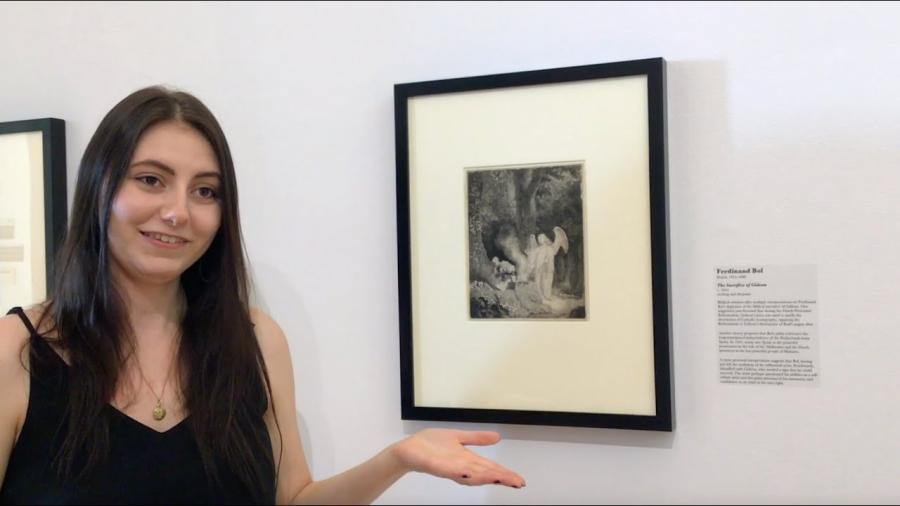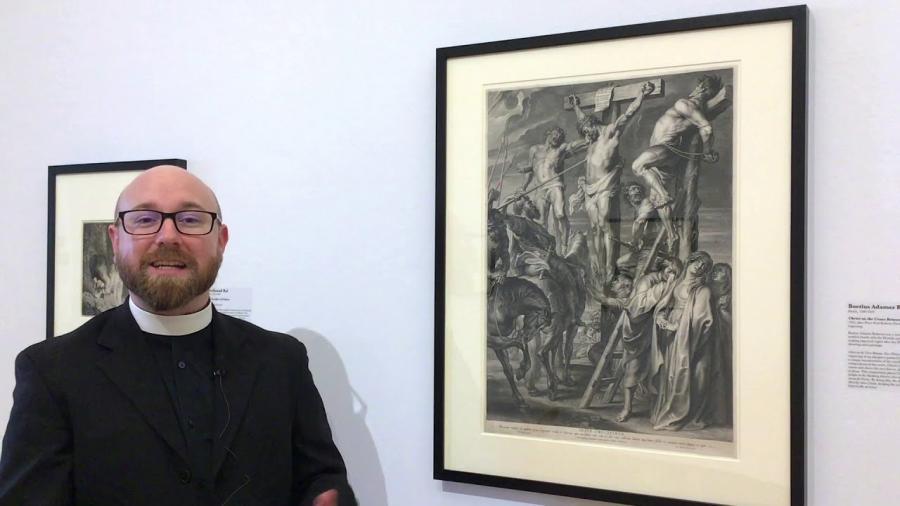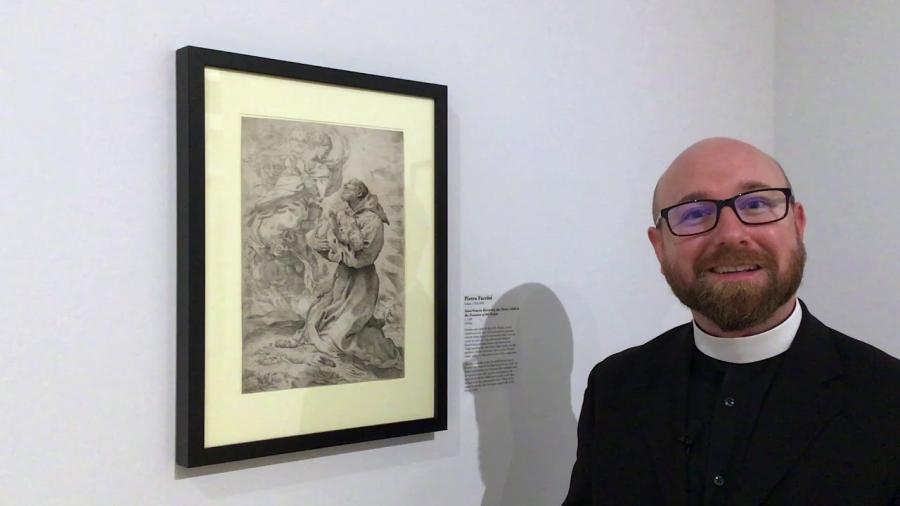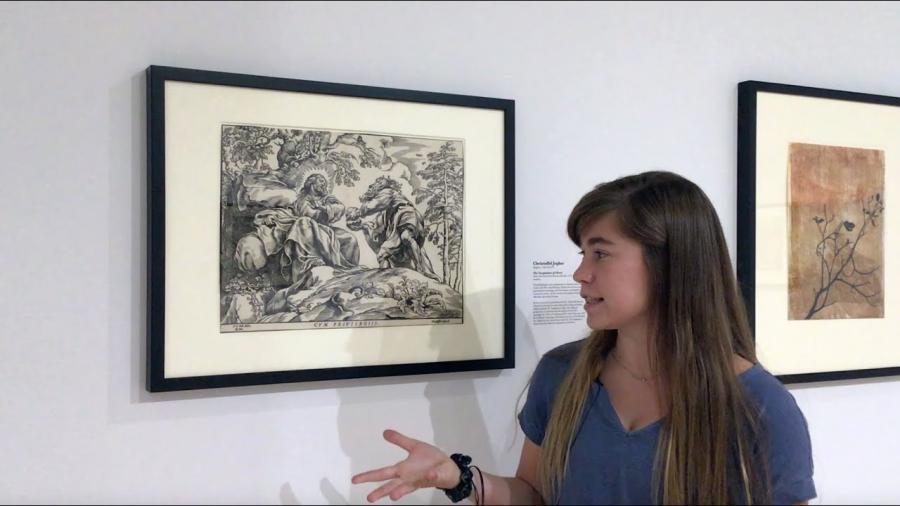Andrew Fairbairn Affleck (British, 1869-1935)
The Towers of Calais
1925
etching and drypoint
The Scottish born Andrew Fairbairn Affleck specialized in making etchings of architectural monuments throughout Europe. In The Towers of Calais, Affleck depicts the central square of Calais, a city in the northernmost part of France. The Tour de Guet, on the right, dates from 1229 when it was built as the town’s watchtower. The bell tower of City Hall, which stands to the left, was destroyed in World War II and reconstructed in a different style. Thus, Affleck’s etching is a picturesque remembrance of the two towers from former times.
Heinrich Aldegrever (German, 1502–c. 1555)
The Large Wedding Dancers: A Couple Embracing (Plate six from the series The Large Wedding-Dancers)
1538
engraving
Heinrich Aldegrever was a German engraver who depicted everyday-life situations in sixteenth-century Germany. He made two series depicting a wedding. The larger series has twelve plates portraying the master of ceremonies, the torch bearers, seven couples, and the musicians; viewed side-by-side, the series creates a festive wedding procession.
Plate six, titled Embracing Couple, documents the lavish styles and customs of courtly life. The highly detailed engraving chronicles the couple’s costumes, jewelry, weaponry, and hairstyles, demonstrating Aldegraver’s goal of communicating the joyous event rather than creating specific portraits of wedding guests.
Aldegraver’s monogram, a large “A" with a small “G” tucked under the bar of the “A,” was his own variation of Albrecht Dürer’s similar monogram.
Adolphe Appian (French, 1818-1898)
Port de San Remo
1878
etching
Adolphe Appian trained in Paris, where he was part of the circle of Barbizon artists, relating to their popularization of landscape subjects. Seeking new and pleasing subjects, he often traveled to the French and Italian Riviera to sketch the Mediterranean coastline.
Today, the Port of San Remo is an active center for yachting, tourists, and nightlife. In 1878, however, Appian’s depiction of the Italian Riviera port was a small, quiet beach with fishing boats on the left and the old Meteorological Observatory to the right. As in so many nineteenth-century Etching Revival prints, the landscape selected by the artist was picturesque and quaint, capturing the charms of a quiet coastal town.
R. Anthony Askew (American, b. 1939)
Santa Fe # 2
2011
monotype
R. Anthony “Tony” Askew is a longtime Santa Barbara resident, celebrated artist, and respected educator. In 1984, Askew began teaching art at Westmont College, where he impacted the lives of countless students and served as the founding director of the Reynolds Gallery, now the Westmont Ridley-Tree Museum of Art.
Beginning in 1988, Askew spent his summers and sabbaticals in Santa Fe, New Mexico. Here, he learned innovative printmaking techniques including the monotype, which became his signature process. Askew’s prints from Santa Fe, most of which are abstract, are drenched in color, paying tribute to the desert environment and Native American arts and culture. Santa Fe #2 responds to the expansive desert vistas and dramatic sunsets that leave the surrounding mountains infused with purple hues.
Cornelis Pietersz Bega (Dutch, 1631/32 –1664)
Three Peasants by a Fireplace
c. 1650
etching
Cornelis Bega flourished as a painter and printmaker in the Golden Age of Dutch art. He is well known for his genre scenes, especially interior settings in taverns or homes, usually showing rustic people eating, drinking, or relaxing.
Bega’s etchings were typically delicate and highly finished, but Three Peasants by a Fireplace is executed quickly with cross hatching in the background and course, tangled lines that define the characters grouped around the hearth. The bright highlights on the figures are intended to portray the warm, intense light of a fireplace at night.
Bartolomeo Biscaino (Italian, 1629-1657)
The Finding of Moses
1650–57
etching
The Finding of Moses tells the story of God’s protective hand on Moses’ life. To control the Hebrew slave population, Egyptian rulers ordered that all male Hebrew infants be drowned. Moses’ mother saved her son from harm by hiding him on the Nile River, not knowing he would be found and raised by Pharaoh’s daughter. The etching depicts the moment three bathing women find the baby floating in a basket; Miriam, Moses’ sister, hides in the rushes, waiting for the action to unfold.
Christoffel Bockstorffer (German c.1480-1553)
David Playing the Harp before Saul
1531
etching
In the etching David Playing the Harp before Saul, Christoffel Bockstorffer’s subject is drawn from the biblical story recorded in I Samuel where a young David plays music to calm an agitated King Saul. The banner above David reads: IM ERSTE BVOCH SAMOEL / DAS XVI CAPITEL, which translates from German: “In the first Book of Samuel/The sixteenth chapter.” In that text, David plays music for Saul just prior to David’s heroic act of killing the giant Goliath, which brought David fame and recognition from the kingdom, but jealousy and loathing from King Saul.
Jean Jacques de Boissieu (French, 1736 -1810)
Vue de Saint-Andéol, en Lyonnais
1774
etching
Jean Jacques de Boissieu etched a view of Saint Andéol at a time when the French town was a bustling marketplace for textiles and wine. The artist found beauty in simplicity, portraying a scene of everyday life in a small French town. Stylistically, it is a good example of Boissieu’s strong influence by the Dutch masters. The artist infuses soft atmospheric effects to the rural scene and demonstrates a skilled use of light and shadow and keen attention to architectural details. It is a busy composition, yet Boissieu creates a calm moment by drawing the viewer's focus to an old cross where a man kneels and prays.
Ferdinand Bol (Dutch, 1616-1680)
The Sacrifice of Gideon
c. 1641
etching and drypoint
Biblical scholars offer multiple interpretations on Ferdinand Bol’s depiction of the biblical narrative of Gideon. One suggestion puts forward that during the Dutch Protestant Reformation, Gideon’s story was used to justify the destruction of Catholic iconography, equating the Reformation to Gideon’s destruction of Baal's pagan altar.
Another theory proposes that Bol’s print celebrates the long-anticipated independence of the Netherlands from Spain. In 1641, many saw Spain as the powerful persecutors in the role of the Midianites and the Dutch provinces as the less powerful people of Manasse.
A more personal interpretation suggests that Bol, having just left the workshop of the influential artist, Rembrandt, identified with Gideon, who needed a sign that he could succeed. The artist perhaps questioned his abilities as a self-reliant artist and this print announced his autonomy and confidence as an artist in his own right.
Boetius Adamsz Bolswert (Dutch, 1580-1633)
Christ on the Cross Between Two Thieves
1631; after Peter Paul Rubens (Flemish, 1577-1633)
engraving
Boetius Adamsz Bolswert was a renowned engraver who worked closely with the Flemish artist Peter Paul Rubens, making engraved copies after the Dutch master’s drawings and paintings.
Christ on the Cross Between Two Thieves was a reproductive engraving of a c. 1619 altarpiece painted by Rubens, who chose a unique interpretation of the crucifixion. In many compositions of this scene, Christ’s placement in the center and above the two thieves, draws the viewer’s eye to Jesus. This composition places Christ at the same height as the flanking thieves who are turned inward towards Christ. By doing this, the thieves guide the focus directly onto Christ, keeping the scene dramatic and historically accurate.
Schelte Adamsz Bolswert (Dutch, 1581-1659)
Rest on the Flight into Egypt
1650-59, after Anthony van Dyck (Flemish, 1599-1641)
engraving
Schelte Adamsz Bolswert was a celebrated seventeenth-century Dutch engraver, who is best known for his work with Peter Paul Rubens, although he also worked alongside other Dutch and Flemish artists. Anthony van Dyck, a student of Rubens, collaborated on a number of prints with Bolswert, who was able to capture van Dyck’s loose and unrestrained style.
In Rest on the Flight into Egypt, van Dyck’s composition includes an expansive landscape, yet the artist also demonstrates his skill with figures. In copying the painting, Bolswert uses a sharp linear structure and understated modeling to give a meditative atmosphere to the print.
Ludolph Büsinck (German, c. 1600–1669)
Moses with the Tablets of the Law
1627-1630; after Georges Lallemand (French, 1575-1636)
chiaroscuro woodcut
Ludolph Büsinck was a German woodcut printmaker. While working in Paris, he introduced French artists to a German relief printing process called chiaroscuro woodcuts. Moses with the Tablets of the Law is a good example of this technique. The image is printed from three separate blocks: a black line block, which creates the contours and two blocks that add ochre and brown tones to the work. Printmakers were drawn to this technique because the finished print took on the high contrast tones of a “light and shadow” pen and ink wash drawing. Moses with the Tablets of the Law was based on a drawing by the French artist Georges Lallemand, for whom Büsinck reproduced many drawings as chiaroscuro woodcuts in the 1620s.
Jacques Callot (French, 1592–1635)
The Conversion of St. Paul
after 1621, before 1629, published by Israël Henriet (French, ca. 1590–1661)
Etching
The Conversion of St. Paul was a subject that Callot depicted several times. As a Jewish zealot, Saul was trying to eliminate devotees of the new religion of Christianity. Traveling to Damascus to arrest Christians, Saul and his men were suddenly exposed to a powerful light that caused Saul to fall down to the ground. A voice came from the sky, announcing himself as Jesus and asking why Saul was persecuting him. The churning drama of Callot’s composition underscores the spectacle of Saul’s conversion.
David Young Cameron (Scottish, 1865-1945)
Thermae of Caracalla
1923
etching and drypoint
With his skill in drypoint, the prolific printmaker David Young Cameron is considered one of Scotland’s most influential graphic artists. Thermae of Caracalla is Cameron’s portrayal of the second largest Roman public baths. His viewpoint is of the entrance into what was a series of hot, tepid, and cold baths. On the right and left, were vaulted chambers, which served as study rooms, a library, shops, and more.
In Roman times, the baths were lavishly decorated, intended as a symbol of Rome’s affluence. In Cameron’s 1923 portrayal of the thermae, the decoration is gone, many walls and ceilings have vanished, yet the artist’s print still captures the grandeur of the architecture.
Canaletto (Giovanni Antonio Canal) (Italian, 1697–1768)
The Equestrian Monument from the series Vedute
1735-1746
etching
Giovanni Antonio Canal, or Canaletto, was fascinated with a practice called vedute, detailed, large-scale paintings or prints of familiar cityscapes or landscapes. His realistic details and atmospheric effects within his vedute are what made Canaletto one of the most highly revered landscape painters of the eighteenth century.
With thin, soft, and undulating lines, the etching, The Equestrian Monument, is a good example of Canaletto's graphic skill. It depicts the Renaissance equestrian statue of the military leader, Bartolomeo Colleoni, which stands in the Campo Santi Giovanni e Paolo, a town square in Venice.
Annibale Carracci (Italian, 1560-1609)
Madonna and Child with Saints Elizabeth and John the Baptist
1606
engraving and etching
Annibale Carracci was among the influential leaders of the Italian Baroque art movement. He changed Italian painting from Mannerism, which valued artificiality, elegance, and sensuous distortion of the human figure, to a more emotionally-driven style that ushered in the later Baroque movement.
Madonna and Child with Saints Elizabeth and John the Baptist depicts an intimate scene of the Christ child with his mother, aunt, and cousin. The Madonna holds the infant Jesus on her lap, offering a bowl from which a young John the Baptist drinks. Behind them, Saint Elizabeth holds her hand out in prayer.
Giovanni Benedetto Castiglione (Italian, 1609-1664)
Discovery of the Bodies of Saint Peter and Saint Paul
1647-51
etching
Castiglione depicts a scene from The Golden Legend, a compilation of stories published in 1275 based on the lives of Christian saints. The etching depicts Saint Peter and Saint Paul, who were both sentenced to death by Agrippa. Later their bodies were stolen during the Roman persecution of Christians. The grave robbers hid the bodies in the Roman catacombs, but a group of Christians, following the robbers, recovered the bodies. The etching depicts the moment when a group of men fill the door of the tomb, one holding a torch to better see the beheaded Paul lying next to a bearded Peter, who holds the Keys to Heaven.
Adriaen Collaert (Dutch, c. 1560-1618)
The People of Judah Rejoicing over the Oath to the Lord, Plate II, from Enconium Musices
c. 1589; after Johannes Stradanus (Flemish, 1523-1605)
engraving
The People of Judah Rejoicing over the Oath to the Lord is an engraved copy after Johannes Stradanus’ series, Encomium Musices, which included sixteen plates illustrating various biblical stories where music played a prominent role. The Old Testament story told in II Chronicles 15 begins as the people of Israel have turned away from the Lord. The prophet Azariah encourages King Asa to turn his people back to God, and the ruler complies, tearing down the idols throughout Israel, rebuilding the altar to the Lord, and calling his people together. They sacrificed cattle, goats, and sheep, promising to never turn their backs on God again. As the oath was made, they celebrated with shouting and the blowing of horns.
Dirck Volckertsz Coornhert (Netherlandish, 1519/22-1590)
St. Paul Baptizing in Ephesus
1553; after Maarten van Heemskerck (Dutch, 1498–1574)
engraving
Dirck Volckertsz Coornhert was a Dutch artist, politician, writer, theologian, and philosopher. He was an early advocate for religious tolerance and is considered the founder of Dutch Renaissance scholarship. Coornhert and Maarten van Heemskerck collaborated on a number of projects, which were widely popular throughout the Dutch community.
St. Paul Baptizing in Ephesus is a good example of van Heemskerck’s interest in depicting religious stories not often found in the art of medieval Christianity. It portrays the moment where Paul, after meeting twelve followers of Christianity, baptized them in the name of the Holy Spirit. A dove, representing the Holy Spirit, flies over the crowd towards the man being baptized.
Victor Delhez (Belgian, 1902-1985)
War in Heaven from series Apocalypse (Book of Revelation)
1957
wood engraving
Victor Delhez was a twentieth-century engraver, who masterfully integrated his fascination with apocalyptic Bible stories and his love of the fantastical aspects of Surrealism.
A subject popular among artists for many decades, the War in Heaven is a biblical story from Revelation, describing the war between the angels led by the Archangel Michael and the angels led by Satan. Delhez depicts Michael as a towering figure in white and the Devil as a fallen figure dressed in all black. The print is dark and unnerving, but the story is a celebration; Christianity has triumphed over dark forces--good has conquered evil.
Francis Dodd (British, 1874 - 1949)
Verona – View of the Piazza delle Erbe
1914
etching and drypoint
The Piazza delle Erbe is the main market square in Verona, Italy and has been the center of the city’s economic and political life for centuries. The view in Dodd’s etching is of the Maffei Palace in the northwestern part of the square. The seventeenth-century Baroque-style home includes a tour de force helicoidal staircase, which curves through the center of the building.
In front of the palace stands a marble column, which holds a statue of St. Mark’s Lion, the symbol of the Republic of Venice. Verona joined the Republic of Venice in 1405, but in 1508, it was captured by Maximilian I. Following its return to the Republic nine years later, citizens celebrated by placing a monument of St. Mark’s Lion in the Piazza, signifying Verona’s fidelity to the Republic of Venice.
Albrecht Dürer (German, 1471-1528)
Christ Carrying the Cross from series Passion
1512
copper-plate engraving
Albrecht Dürer was a Renaissance artist who revolutionized printmaking, changing its status as merely a reproductive technique into a respected art form. Through his introduction of classical motifs, Dürer is one of the greatest artists of the Northern Renaissance.
Christ Carrying the Cross is from Dürer’s Engraved Passion series and depicts the moment after Jesus was sentenced to death and forced to carry his cross to his crucifixion. Saint Veronica is seen kneeling to the left of Jesus holding a cloth. It is said that she offered her veil to him, which he took and pressed to his face, leaving the imprint of his appearance. This cloth, known as Veronica’s Veil, is one of the most treasured relics of the church, rumored to be held at the Vatican.
Albrecht Dürer (German, 1471-1528)
Saint Christopher Facing Left
1521
engraving
Saint Christopher lived in the third century and was an unusually tall man, towering over others. After vowing to serve the strongest leader he could find, Christopher pledges his allegiance to a king, but leaves after discovering that the king feared the devil. Christopher then decides to serve the devil, but soon leaves the devil after learning that the devil fears the Christian God. Searching for God, he meets a hermit and learns he could serve God by helping people cross a treacherous river. One day, a child asks for Christopher’s help. Picking up the child, Christopher wades through the river, but the child becomes heavy, weighing them both down. Safely across, Christopher learns he was carrying the Christ Child with the weight of the world on his shoulders.
Sir Anthony van Dyck (Flemish, 1599-1641) and Lucas Vorsterman I (Dutch, 1595-1675)
Christ Crowned with Thorns--The Mocking of Christ
c. 1630
etching and engraving
Sir Anthony van Dyck trained in the workshop of Flemish master, Peter Paul Rubens, which is where he met and began collaborating with Lucas Vorsterman I, an engraver in Rubens’ workshop. The two worked as a team on many reproductive prints with van Dyck as the designer and etcher and Vorsterman as the engraver.
Christ Crowned with Thorns--The Mocking of Christ is an example of van Dyck and Vorsterman’s successful collaboration. The first state of four was a light outline drawn by van Dyck. The next three states have additional engraving by Vorsterman, which add rich detail to the scene. The chiaroscuro technique reveals the holiness of Jesus, as he is depicted in lighter tones with a white halo around his head.
Fritz Eichenberg (German/American, 1901-1990)
And Their Eyes were Opened page 2 from the portfolio: Ten Wood-engravings from the Old Testament
1955
wood engraving
Fritz Eichenberg was a master of wood engraving, especially adept at making detailed white-line wood engravings. To make a white-line engraving, an artist carves into hardwood panels (like boxwood or cherry) to make thin, meticulous lines. When inked, it is the crevices that hold the ink, not the relief lines, and the contours of the composition appear as white lines.
And Their Eyes were Opened is a good example of the dramatic results Eichenberg achieved with white-line engraving. It depicts the fall of man, portraying an ashamed Eve covering her face, Adam fearfully holding the forbidden fruit, and an angel watching as the pair's eyes are opened to sin and separation from God.
Pietro Faccini (Italian c.1562-1602)
Saint Francis Receiving the Christ Child in the Presence of the Virgin
c. 1590
etching
Scholars who study the life of St. Francis, record variations on the story of Francis and his encounter with the infant Jesus. A seventeenth-century account recalls the story of a friar who secretly followed Francis into an isolated forest and witnessed the Virgin handing him the Christ Child. Earlier records mention a similar encounter, but it was not Francis’ vision, rather, a vision given to one of his companions.
Another possibility is that the artist Faccini depicts Francis’ recreation of the Nativity in Greccio, Italy. As Francis preached at the Christmas Eve midnight mass, he was overcome with emotion and picked up the figure of the Christ Child from a crèche at the altar, holding it for the congregation to see. Those in the crowd swear they saw the image come to life as the Christ Child.
Henri Fantin-Latour (French, 1836 - 1904)
À Robert Schumann (To Robert Schumann)
1893
lithograph with chine appliqué
On a visit to England in 1859, Henri Fantin-Latour encountered the music of German Romantic composers like Robert Schumann, Hector Berlioz, and Richard Wagner. Music stirred a deep and romantic passion in Fantin-Latour, and he created many lithographs honoring composers, musicians and operas.
In 1893, he painted À Robert Schumann, which presents six female figures wearing gossamer gowns in front of a hovering angel who crowns a marble bust of Schumann with a floral garland.
Philips Galle (Flemish, 1537-1612)
Temperance from the series Seven Virtues
c. 1559; after Pieter Bruegel the Elder (Flemish, c.1525-1569)
engraving
Pieter Bruegel is known for his paintings based on the daily lives of Flemish peasants, but he also used his multifaceted talents on the more extraordinary themes of Heaven, Hell, and other allegorical subjects. He had a long-established relationship with publisher Hieronymus Cock and commissioned many of Cock’s atelier of engravers, including Philips Galle.
Temperance is a part of Bruegel’s series on the Seven Virtues, all engraved by Galle, which succeeded Bruegel’s series on The Seven Deadly Sins. Temperance, depicted as a woman, stands in the center, while the encircling groups busy themselves with work. Choir singers and actors perform; cosmographers try to measure a billow of smoke; surveyors evaluate weaponry and battlements. In the left foreground, there are moneylenders working to balance their books, and to the right, students frantically studying.
Hendrick Goltzius (German-born, Dutch, 1555-1616)
Nox
c. 1588-95
chiaroscuro woodcut
Hendrick Goltzius’ classically oriented, ambitious, and investigative approach to printmaking is manifest in his experimental chiaroscuro woodcut, Nox, one of a series of seven oval woodcuts generally designated as The Deities. Demogorgon represents creation, and then three male/female pairs represent the sea (Oceanus and Tethys), the underworld (Pluto and Proserpina), and the heavens (Helios and Nox). Nox, or “Night,” rides a chariot drawn by bats, and is carrying a personification of sleep. Above sleep’s head, astrological signs designate the hours of the night. Nox is accompanied by an owl and a cock, birds designating the beginning and the end of the Night’s reign.
Hendrick Goltzius (German born, Dutch, 1555-1616)
The Holy Family with Young John the Baptist
c. 1593
engraving
The Holy Family with the Young John the Baptist is the last in a series of six prints by Goltzius on The Life of the Virgin. To appeal to both Catholics and Protestants, Goltzius chose a subject--the Virgin Mary--dear to the hearts of Catholics, but sufficiently rooted in scripture to honor Mary’s virtue and motherliness so as to be attractive to Protestants as well. In The Holy Family, the vase of lilies on the left and the sewing basket on the right are symbols of virginal purity and domestic dutifulness.
Hendrick Goudt (Dutch, 1583-1648)
Jupiter and Mercury in the House of Philemon and Baucis
1612; after Adam Elsheimer (German, 1578-1610)
engraving and etching
Jupiter and Mercury in the House of Philemon and Baucis is a story from Ovid’s Metamorphoses. Philemon and Baucis were an elderly couple living in the town of Phrygia. They opened their home to two weary travelers, who, unbeknownst to them, were the gods Jupiter and Mercury. The gods recognized the sacrifice made by this couple to feed and house them and rewarded their generosity by miraculously replenishing the wine bowl throughout the evening. Once the gods revealed themselves, they took the couple atop a mountain. The four watched as Phrygia flooded, except for the couple’s cottage, which transformed into a temple. With gratitude, Philemon and Baucis became priests of the temple, and when they died, their bodies became a linden and an oak tree beside their old home.
Eugène Isabey (French, 1803-1886)
Ruins de Château de Bouzols près Du Puy en Velay – Auvergne from portfolio Voyages Pittoresques et Romantiques dans l'Ancienne France, 1830-31
1831
lithograph
Eugène Isabey was an illustrator for the Voyage Pittoresque et Romantiques de l’Ancienne France, a series of twenty-six volumes promoting French history by documenting ancient and medieval monuments, churches, castles, and landscapes in France. Artists traveled to specific sites to make first-hand sketches, allowing readers to become “armchair travelers” in their own country.
Ruins of the Castle Bouzols was an illustration in one of the two volumes on Auvergne, France. From the light-drenched foreground to the darker middle ground, the Castle Bouzols stands as a white beacon on a dramatic hilltop.
Christoffel Jegher (Belgium, 1596-1652/53)
The Temptation of Christ
1633; after Peter Paul Rubens (Flemish, 1577-1640)
Woodcut
Christoffel Jegher was a printmaker in Antwerp who worked closely with Peter Paul Rubens. Rubens focused on large, time-intensive paintings, and hired master printmakers to recreate his works, which circulated throughout Europe efficiently spreading his fame.
Rubens received a commission from St. Charles Borromeo Church in Antwerp to create thirty-nine ceiling paintings, which included The Temptation of Christ. He designed preparatory oil sketches and his pupils executed the paintings. In 1718, a fire destroyed the vault of the nave and all of Rubens’ paintings. Fortunately, because of his sketches, the designs for the church have survived. The Temptation of Christ is based on Rubens’ preparatory oil sketch.
John Baptist Jackson (British, c. 1700-c. 1777)
The Crucifixion
1741; after Jacopo Robusti (called Tintoretto) (Italian, 1518-1594)
woodcut
Jackson’s woodcut The Crucifixion was based on a painting by famed Italian artist Jacopo Robusti, or Tintoretto, an Italian Mannerist artist known for his use of dramatic flair and unusual compositional perspectives. The print depicts a panorama of Golgotha, the site of Christ’s crucifixion. Jackson used four blocks in shades of brown and beige to achieve Tintoretto’s compositional depth. The lighter colors are first, creating the sky and Christ’s halo. The two darker shades are added before the final block of dark brown, which creates contours, shadows, and outlines.
Martha Ensign Johnson (American, b. 1954)
Aftermath II
2012
two plate etching on top of a wood block print
On November 13, 2008, a fire swept through the foothills of Montecito, California. At the time, Martha Ensign Johnson was teaching printmaking at Westmont College, which lost multiple buildings and fifteen faculty houses in the fire. In the following months and years, Johnson collected bits and pieces of nature as she walked to her classroom. She was curious about how fire affects flora and fauna, and she noticed how quickly vegetation reappeared and birds and insects came back to the area. This restoration is what inspired Aftermath II, a meditation on the land’s renaissance.
Willem van der Leeuw (Belgium, 1603-1665)
Daniel in the Lion’s Den
after 1625; after Peter Paul Rubens (Flemish, 1577-1640)
engraving
Art historians believe that Peter Paul Rubens painted Daniel and the Lion’s Den entirely on his own, which was rare as he had a team of assistants who usually completed his works. While Rubens had the benefit of color to underscore emotion in Daniel’s story, Willem van der Leeuw’s engraving successfully translated the drama of the painting using only black and white. He made small changes, like surrounding Daniel in light to create a stark contrast with the dark background. In the painting, the fabric covering Daniel’s body was red, symbolic of blood. In the engraving, the fabric is white, a possible reference to the shroud of Christ.
Alphonse Legros (French, 1837-1911)
Tête d’Homme (Head of a Man)
c. 1877
etching, drypoint, and aquatint
Portraits, both painted and etched, were a hallmark of Alphonse Legros’ oeuvre. Among his well-known portrait etchings are fellow artists and literary figures including: Sir Seymour Hayden, Henry Wadsworth Longfellow, Alfred Tennyson, and Auguste Rodin. The subject of Tête d’Homme is an unidentified man. Although Legros’ etchings were typically lighter and more detailed, the rich black surface is not without precedent in his etched work.
Donald Shaw MacLaughlan (Canadian/American, 1876-1938)
The Lauterbrunnen
1908
etching and drypoint
Donald Shaw MacLaughlan is well-known among twentieth-century etchers in America. In 1908, he took a trip to Switzerland, where he created the print The Lauterbrunnen, which depicts the Lauterbrunnen Valley in the Swiss Alps.
The Lauterbrunnen demonstrates the thoughtfulness and precision MacLaughlan used in his etchings. A crispness in the foreground is achieved through his liberal use of ink, while the background’s restrained use of ink produces an atmospheric haziness. The setting emphasizes MacLaughlan’s interest in the Aesthetic Movement, highlighting visual qualities over moral, practical, or narrative intentions – otherwise known as art for art’s sake. McLaughlan presents the dramatic vista in The Lauterbrunnen to be enjoyed for its inspired beauty and exceptional artistry.
John Martin (British, 1789-1854)
Fall of Nineveh from the series Illustrations of the Bible
1835
etching and mezzotint
John Martin gained notoriety as the apocalyptic artist of his time. Beginning in 1831, Martin commenced his most ambitious endeavor, Illustrations of the Bible. Due to financial problems, Martin abandoned the series and sold the completed twenty plates to the publisher Charles Tilt, who produced a bound edition of the prints.
Fall of Nineveh was the last illustration Martin made for the series and depicts the destruction of Nineveh foretold in the book of Nahum. Around 612 BC, catastrophic floods tore down the walls of the city, allowing enemies to enter, as seen in the background of the print. In the foreground, the Ninevites scatter as their king, Sardanapalus, orders men to construct a funeral pyre on which he, with his concubines and treasures, would burn to death.
Jacob Matham (Dutch, 1571-1631)
The Four Elements, plate 1 from the series Mythological and Allegorical Subjects
1588; after Hendrick Goltzius (Dutch, 1558-1617)
engraving
Jacob Matham was the stepson of the Dutch artist, Hendrick Goltzius and worked primarily for his stepfather in his early career. Designed by Goltzius and engraved by Matham, The Four Elements is the first plate from a series titled Mythological and Allegorical Subjects. In the top right corner, “Fire” is seated on a salamander (an attribute of fire) with flints in each hand. “Air” is seated in billowing clouds, holding a chameleon, which was believed to subsist on air. In the bottom left sits “Earth,” holding vegetables and fruit with a headdress of vegetation and a walled tower. Finally, “Water” reclines in the center, holding a conch shell and wearing a crown fastened with a model ship.
Jan Muller (Dutch, 1571-1628)
Lot with his Two Daughters
c. 1600
engraving
Lot and his Daughters depicts the biblical story of Lot. An angel warns Lot of his city’s impending destruction. Lot flees Sodom with his two daughters to roam the hills and live in caves. His daughters, fearing that all other men had perished, decide to intoxicate their father and lie with him to continue their family line.
Sixteenth-century Northern European artists popularized the story of Lot and his daughters, engaging viewers with a moral dilemma. Although Lot committed incest, the Bible states he was too drunk to realize what he was doing. Furthermore, his daughters were not driven by lust but by a desire to perpetuate their family line. Using symbols associated with erotic and redemptive metaphors, Muller forces the viewer to confront the same tensions theologians have long questioned.
Franz Xaver Karl Palko (Czech, 1724 – c. 1767)
God Breathing Life into Adam
c. 1760
etching
God Breathing Life into Adam is one of only four etchings that Palko completed during his career. The subject is taken from the Genesis creation story, as God gives life to Adam, resulting in a perfect communion between humankind on earth and God in paradise.
The composition shows God literally breathing a stream of air into Adam, a visual trope that dates back to Gothic mosaics and stained glass windows, and old master German woodcuts. God floats in the air above Adam, breathing his own being, the “I AM,” which Adam inhales, thus animating his body and soul. The sheep and the rabbit set the location of the story in the Garden of Eden.
Giovanni Marco Alvise Pitteri (Italian, 1702-1786)
Saints Thaddeus, Bartholomew, Paul, Matthew from the series The Holy Family and Apostles
1742–1744; after Giovanni Battista Piazzetta (Italian, 1682-1754)
engraving
Giovanni Marco Alvise Pitteri was an Italian engraver known for a technique he developed that produced highly finished, realistic prints. The technique involved densely incised lines to create volume and heavy cross hatching with tiny bumps and knobs, to produce shading and textures.
Pitteri often collaborated with Giovanni Battista Piazzetta, whose realistic portraits were popular in Venice and throughout Europe. One of the pair’s most celebrated series was The Holy Family and Apostles, which included these four prints.
Maria Katharina Prestel (German, 1747–1794)
Die Wahrheit triumphiert über den Neid (Truth Triumphs over Envy also titled Virtue Overcoming Vice) Plate 24 from the series Divers Cabinets
c. 1780; after Jacopo Ligozzi (Italian, 1547-1627)
etching and aquatint in brown and ochre ink, touched with gold leaf
Maria Katharina Prestel (originally Maria Katharina Höll) studied art with, and later married, Johann Gottlieb Theophilus Amadeus Prestel. Together, the couple operated a publishing establishment for etchings and aquatints.
Truth Triumphs over Envy is likely copied from a drawing by the Medici court artist Jacopo Ligozzi. Though Johann’s signature appears on the bottom of the print, scholars have recently re-attributed it to Maria Katharina. “Envy” is epitomized as a bearded male on his knees with a mythical monster nestled next to him. “Truth” is represented as a female in a flowing garment, stepping on the male’s hand with her left arm raised, prepared to strike.
Marcantonio Raimondi (Italian, 1480-1534)
Saint Cecilia, Saint Paul, Saint John, Saint Augustin, and Saint Magdalene
1515-1516; after Raffaello Santi (Raphael) (Italian, 1483-1520)
engraving
Saint Cecilia was the patron saint of musicians and church music. Her parents forced her marriage to the pagan nobleman, Valerian, despite her vow of virginity. During their wedding, she sat by herself, singing in her heart to God. When it was time to consummate her marriage, she told Valerian that if he violated her, he would be punished, but if he respected her, he would be cherished by her guardian angel. Valerian respected his wife’s purity and was baptized, looking up to see the angel crowning Cecilia in a chaplet of flowers. Both Cecilia and Valerian were beheaded, becoming martyrs for their faith.
Rembrandt van Rijn (Dutch, 1606-1669)
Christ Driving the Money Changers from the Temple
1635
etching with touches of drypoint
The most prominent artist in the seventeenth-century Dutch Golden Age was Rembrandt van Rijn. Although a skilled painter and etcher, his celebrity rests upon his brilliant storytelling, demonstrated here by the intense drama he revealed in his New Testament narrative of Christ purging the Temple of money changers and merchants who were selling animals for sacrifices.
Theologians have written extensively on the significance of the story. It is likely that the Purge of the Temple took place in Jerusalem only a week before Christ was crucified. Christ’s body is linked to the Temple, and as he drove the animals to be sacrificed out, he was proclaiming Himself as the ultimate sacrifice. Christ was ushering in a new order where His body and blood would be the only redemption for sinners.
Jusepe de Ribera (Spanish, 1591-1652)
The Penitence of St Peter
1621
etching and engraving
The Penitence of Peter depicts the moment right after Peter, identified by his bald head and the Key of Heaven, betrays Jesus by denying him three times. He regrets his actions, begging for forgiveness. He has humbled himself, seeking absolution, which he is later granted by the risen Lord.
Although born in Spain, Jusepe de Ribera’s technique shows the influence of Italian artists, especially evident in the monumental size of the figure and the details of the sandals, the key, and the flowing robe. De Ribera heightens the emotional distress of his subject by adding deep, cross-hatched shadows on Peter’s neck and cheek in contrast to light that hits his countenance and beard.
Peter Paul Rubens (Flemish, 1577-1640)
Saint Catherine of Alexandria
c.1620
etching
Peter Paul Rubens utilized the prolific efficiency of printmaking to bolster his fame throughout Europe, but he was not an expert engraver or etcher and often collaborated with professional printmakers. Scholars have identified only three etchings created by Rubens himself, one being Saint Catherine of Alexandria.
Around 305 AD, it is said that a fourteen-year-old Catherine experienced a vision of Mary and the Infant Jesus and converted to Christianity. The Emperor Maxentius summoned philosophers to dissuade her from her faith, but all who were sent were converted. Sentenced to her death on a breaking wheel, as Catherine approached the wheel, it shattered, forcing the Emperor to behead her instead.
Jan Pieterszoon Saenredam (Dutch 1565 - 1607)
The Annunciation to the Shepherds
1599; after Abraham Bloemaert (Dutch, 1566-1651)
engraving
Throughout his career, Jan Pieterszoon Saenredam produced prints by many well-known artists, including Abraham Bloemaert, a Utrecht artist who specialized in religious scenes set in dramatic landscapes.
The Annunciation to the Shepherds is one of Bloemaert’s most frequently painted subjects. With billowing clouds and a dramatic pastoral scene, Bloemaert creates a dynamic composition depicting the biblical narrative recorded in the Gospel of Luke. A group of angels appear to the shepherds as they watch over their sheep. The angels announce the birth of Christ and tell the shepherds where to find the child.
Johann Adam Schweikart (German 1722 – 1787)
Venus Chastises Cupid
1762; after Antonio Domenico Gabbiani (Italian, 1652 –1726)
etching and aquatint
Johann Adam Schweikart is best remembered as the inventor of aquatint, a method that reproduces the subtle shades and tones of a pen and ink wash drawing. Others had experimented with an open-bite etching technique, where acid was brushed onto a copper plate to randomly bite the copper, but Schweikart is credited with bringing control to the technique by using an acidic paste applied with a brush.
Schweikart reproduced many artists’ works into etching and aquatint, including Antonio Domenico Gabbiani, who created a complex composition of lovers, pushing the amorous action close to the picture plane as though staging a theatrical scene. Schweikart’s heavy etched lines are printed in a rich, dark brown in contrast to the light brown and tan inks of the aquatint tones.
Pietro Testa, Il Lucchesino (Italian, 1612-1650)
The Sacrifice of Isaac by Abraham
c. 1640
etching
The Sacrifice of Isaac by Abraham is a story from the Old Testament book of Genesis. God commanded Abraham to sacrifice his only son, Isaac, to the Lord. As Isaac sits atop the altar, the Lord commands Abraham not to harm Isaac. Noticing a ram caught in a bush, Abraham takes the animal and sacrifices it instead of his son. Abraham’s fidelity to God was rewarded with his son’s life.
Testa creates a dramatic composition, which spirals upwards, taking the viewer’s attention first to Isaac kneeling on the altar, then to Abraham whose arm is pulled back by an angel, while another angel provides the sacrificial ram. Abraham’s face meets God’s gaze, hovering in the clouds, and relief washes over him as he realizes he has been spared this grisly task.
Giovanni Domenico Tiepolo (Italian, 1727-1804)
Joseph and Mary Prepare to Leave plate 5 from the series The Flight into Egypt
1753
etching
Giovanni Domenico Tiepolo was the eldest son of the famous Italian Rococo artist, Giovanni Battista Tiepolo. He created The Flight into Egypt series to prove he could invent twenty-seven compositions on the same subject without repeating himself.
The biblical narrative of the flight is recounted in the Gospel of Matthew and tells of Mary, Joseph, and the Christ Child fleeing to Egypt to escape King Harod’s decree that all young boys were to be killed. Joseph and Mary Prepare to Leave is the fifth etching in the series and depicts Simeon, a devout man of the Lord, meeting Jesus and prophesying his future crucifixion. In most depictions, the Family meets Simeon in the Temple, but Tiepolo chose to place the meeting outside the stable as the travelers prepare to depart.
Joseph Mallord William Turner (British, 1775-1851)
Ben Arthur from series Liber Studiorum
1819; mezzotinter: Thomas Goff Lupton (British, 1791–1873)
etching and mezzotint
The print Ben Arthur depicts a prominent peak in the Scottish Highlands and was created for Turner’s book Liber Studiorum, a series of seventy landscapes and seascapes inspired by his travels. The “M” in the upper margin indicates that the work was categorized under the book’s mountainous section.
Turner began his process by creating a sepia-toned watercolor drawing. Under Turner’s direction, Thomas Goff Lupton, a professional engraver, added mezzotint onto the etching to create velvety depth to the steep ravine. Turner then etched the outlines of the composition onto the sealed plate. The etching and mezzotint was printed with sepia-colored inks to convey a sense of breadth and warmth.
Lucas Vorsterman I (Dutch, 1595- c.1675)
St. Michael Striking Down the Rebellious Angels
1621; after Peter Paul Rubens (Flemish, 1577-1640)
engraving
Lucas Vorsterman engraved St. Michael Striking Down the Rebellious Angels about three years after he began working as an engraver for Peter Paul Rubens. The engraving depicts an event from the New Testament book of Revelation where the Archangel, Michael, with his army of angels, battles the Devil and his army of fallen angels. Although the book of Revelation is filled with symbolism, Rubens depicted the conflict quite literally with a swirling composition of muscular angels and gruesome monsters. Vorsterman reproduced the design with an innovative process where he used different tools to create unique patterns. He used the burnisher to create highlights on the bodies, so when the plate was inked, the light and dark areas added dramatic effects.
Carol Wax (American, b. 1953)
Under Wraps
2008
mezzotint

